California has more people than any other state of the United States. Many visitors and new residents are attracted by California’s outdoor way of life. The warm, dry climate of southern California permits outdoor recreation almost all the year around.
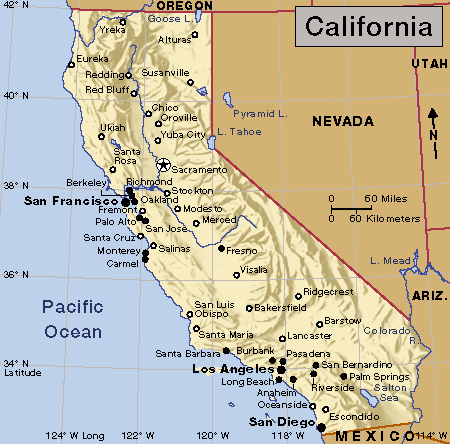
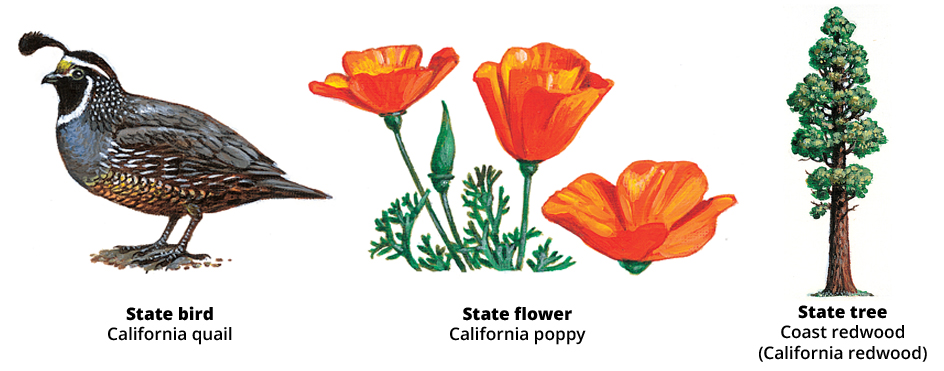
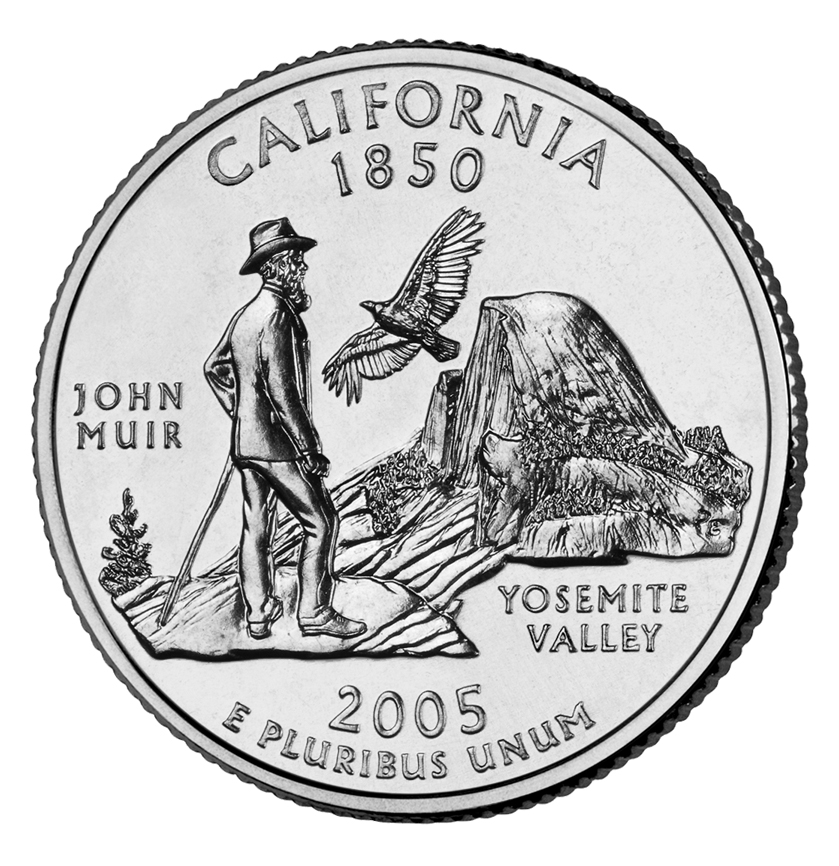
California ranks first among the states in manufacturing. More goods are made there than in any other state. California is the nation’s leader in the manufacture of electronic equipment. Its products also include aircraft and such food products as baked goods and wines. California is a leading mining state as well. For example, its fields of oil and natural gas yield thousands of barrels of fuel a day.
California also ranks first among the states in agriculture. A vast farming region, the Central Valley, extends about 450 miles (720 kilometers) through the center of the state. The valley is the leading region in the United States for growing fruits, nuts, and vegetables.
California is a center of the motion-picture and television industries. Its entertainment products are distributed throughout the world.
California has 4 of the nation’s 20 largest cities—Los Angeles, San Diego, San Jose, and San Francisco. The state capital is Sacramento, another large city.
The international airports at Los Angeles and San Francisco are among the busiest in the world. The ports along California’s Pacific Coast make the state a leading area for international trade with Latin America and Asia.
Hundreds of computer and electronics companies have their headquarters in California. Research laboratories, computer companies, and engineering firms cluster around universities in and near the largest cities. They take advantage of the “brain power” of scientists and engineers from the universities.
California covers a larger area than any other state except Alaska and Texas. The high Sierra Nevada rises near the eastern border. Rocky cliffs and sandy beaches line the shore of the Pacific Ocean in the west. Thick forests of Douglas-firs and redwoods cover the Coast Ranges and the Klamath Mountains in the northwest. Barren deserts stretch across the southeast.
The Spaniards were the first Europeans to colonize California. Franciscan friars from Spain established the first of a chain of missions there in 1769. California is known as the Golden State. Its gold fields attracted thousands of miners, known as the “Forty-Niners,” during the gold rush of 1849. The nickname also suggests the brilliant sunshine the state enjoys.
People
Population.
The 2020 United States census reported that California had 39,538,223 people. The population had increased 6 percent over the 2010 figure of 37,253,956. According to the 2020 census, California ranks first in population among the 50 states.
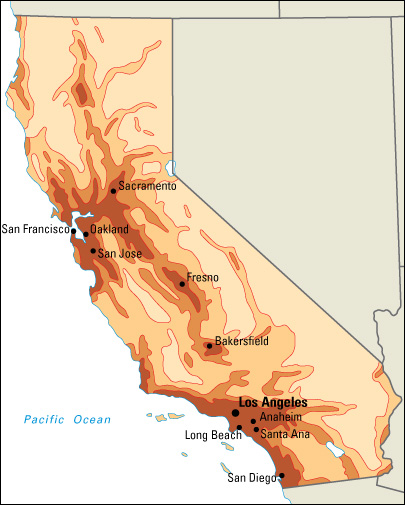
In 1960, California ranked second to New York in population. Unofficial figures indicated that California passed New York early in 1963. By 2020, California had about 19 million more people than New York and 10 million more than Texas, which passed New York in population during the 1990’s.
About 98 percent of the people of California live in metropolitan statistical areas (see Metropolitan area). About 35 percent of California’s population lives in the largest metropolitan area—Los Angeles-Long Beach-Anaheim.
Los Angeles is the largest city, both in area and in population. It covers 469 square miles (1,215 square kilometers). The United States Census Bureau reported that Los Angeles had a population of 3,898,747 in 2020.
California has 13 other cities that each have more than 300,000 people. Only four—Bakersfield, Fresno, Sacramento, and Stockton—are inland. The others lie on or near the Pacific Coast. Oakland, San Francisco, and San Jose are in the San Francisco Bay area. Anaheim, Irvine, Long Beach, Riverside, and Santa Ana are part of the Los Angeles population cluster. San Diego is on the coast near the Mexican border. 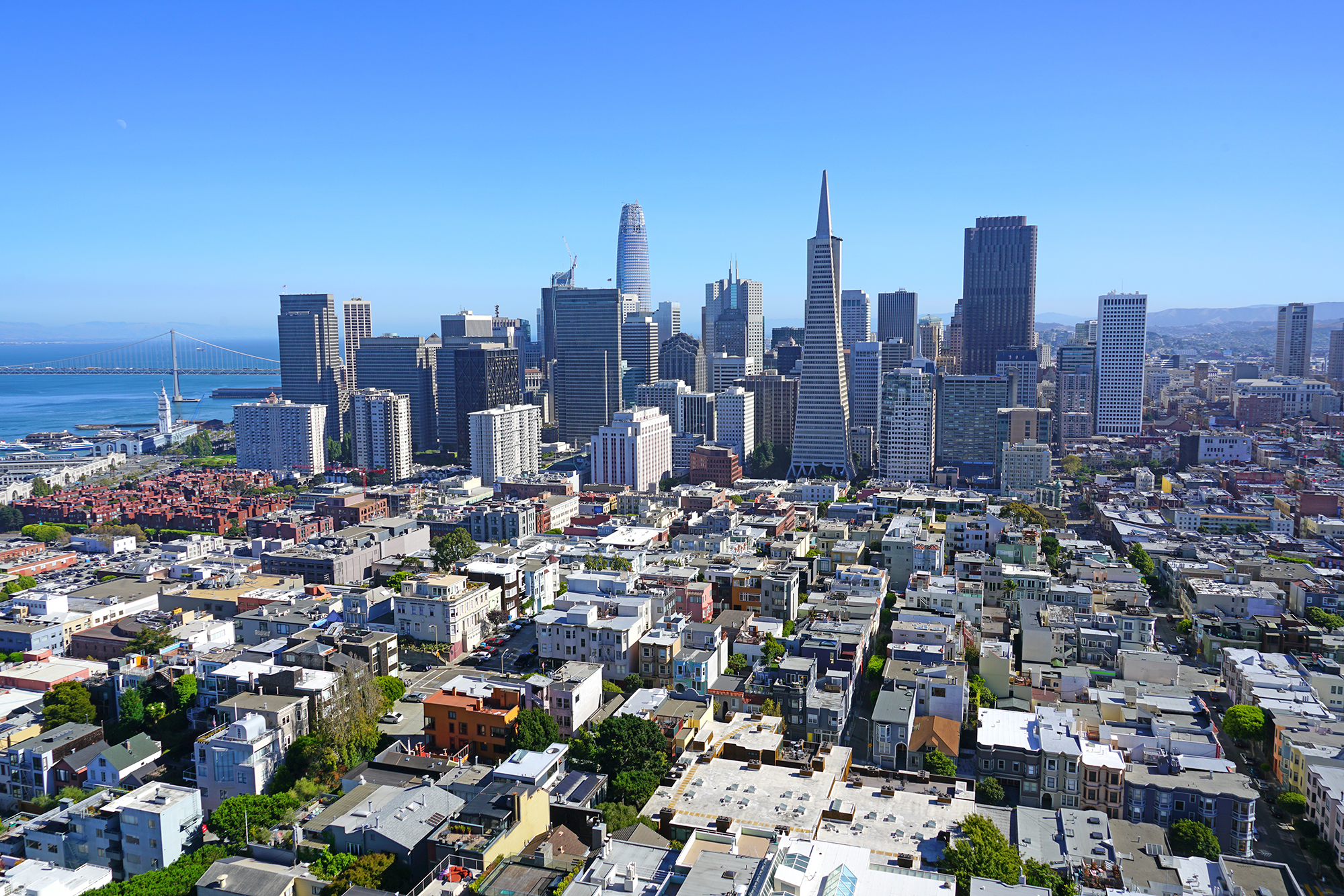
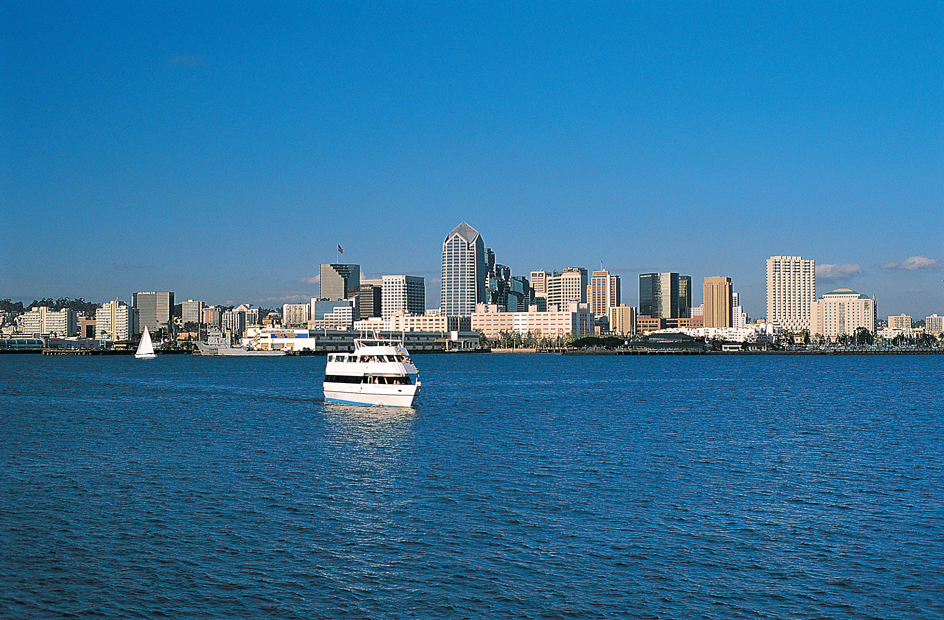
Most Californians were born in the United States. Mexicans make up the largest group of Californians who were born in another country. More people of Mexican ancestry live in the Los Angeles area than in any other urban area in the world outside Mexico. Many Californians of Chinese and Japanese ancestry live in communities of their own in Los Angeles and San Francisco. Chinatown in San Francisco has one of the largest Chinese communities outside Asia. California also is home to many people born in Canada, El Salvador, Guatemala, India, Iran, North and South Korea, the Philippines, Vietnam, and the United Kingdom. About 630,000 Native Americans, also called Indigenous (native) people, live in California—more than in any other state.
Schools.
In the late 1700’s and early 1800’s, Franciscan friars taught farming, weaving, and other crafts to the Indigenous peoples of California. A few small schools were established in the region. But most children of the early settlers received instruction from private teachers.
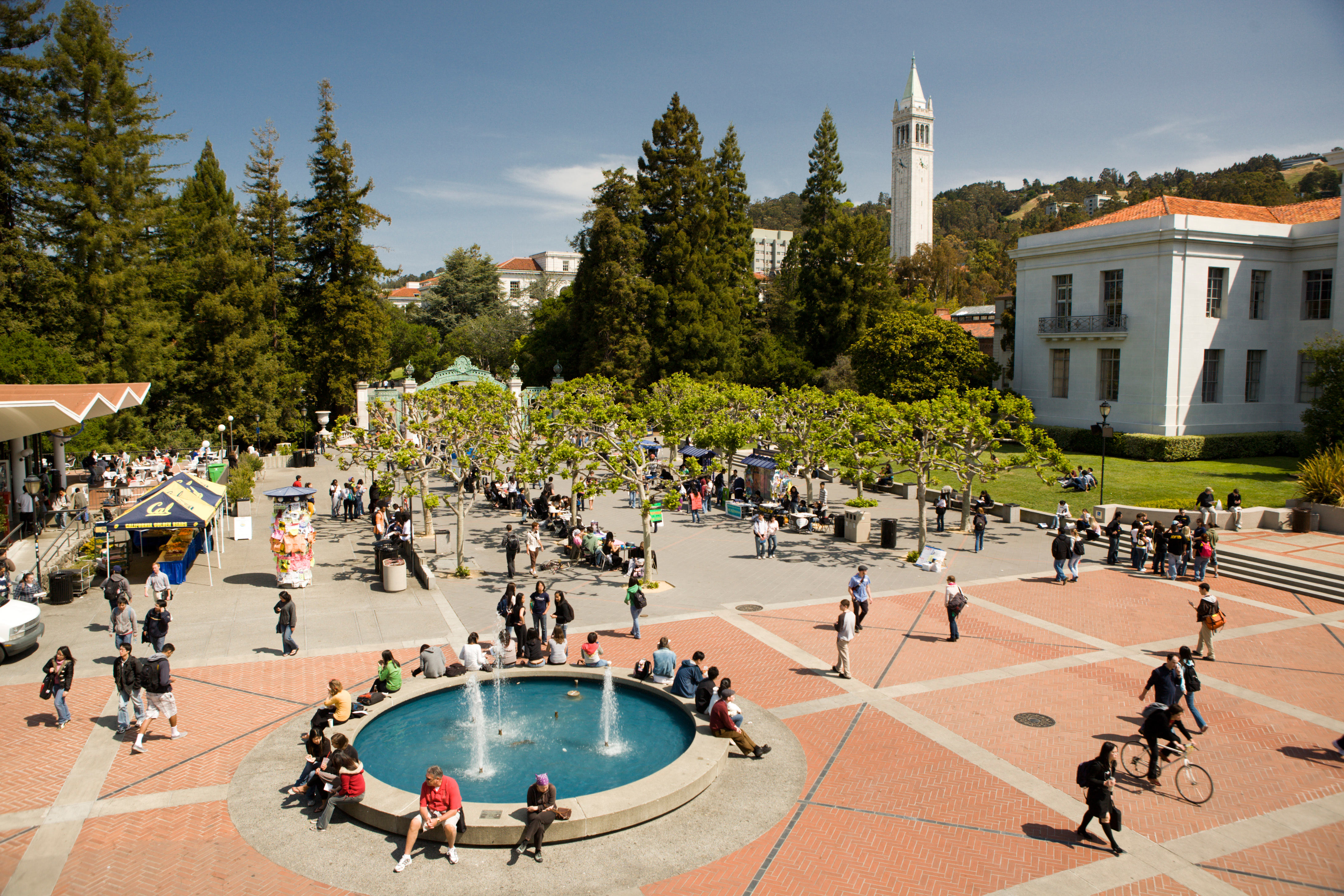
The first tax-supported school in California opened in San Francisco in 1850. It was financed by the city. In 1849, the California Constitution provided for a public school system. The state Legislature passed a tax law in 1852 to support public schools. But the schools did not become free to all children until 1867. At that time, the school system did not include high schools. The state’s first public high school opened in 1856 in San Francisco. In 1910, California established in Fresno the first tax supported junior college in the United States.
An 11-member state Board of Education sets policies for California’s elementary and secondary school system. The members of the board are appointed by the governor, subject to the approval of the state Senate. Members serve four-year terms, except for one student representative, who serves one year. The California Department of Education provides assistance to the state’s local school districts and county offices of education, and it divides state and federal funds among them. An elected superintendent of public instruction heads the department.
With some exceptions, California law requires children from age 6 to 18 to attend school. Students between the ages of 16 and 18 may leave school if they graduate from high school or if they pass a special examination and have parental permission. For the number of students and teachers in California, see Education (table).
California State University is the largest state-supported system of four-year and graduate-level education in the United States. It has more than 20 campuses and over 480,000 students. Another state-supported university, the University of California, has 10 campuses and more than 280,000 students. California also has an outstanding system of community colleges. A master plan, which was approved by the State Legislature in 1960, provides for the orderly expansion of the system of state colleges and universities.
Libraries.
California’s outstanding public library system was founded in 1909. Today, public libraries exist throughout the state. In addition, all types of libraries in California have formal and informal cooperative arrangements between them for sharing resources. The University of California at Berkeley has the largest university library in the state. It includes the Bancroft Library collections of rare materials on the American West. The Hoover Institution on War, Revolution, and Peace at Stanford University has books and documents on political, economic, and social change.
Museums.
The de Young Museum in San Francisco has art objects from many lands. The exhibits include famous paintings by European artists and items made by early Native Americans. The Legion of Honor in San Francisco displays antique furniture, paintings, porcelain, sculpture, and tapestries. The Hollywood Museum in Hollywood displays objects and exhibits on Hollywood’s motion-picture and television industries.
The Huntington Library, Art Museum, and Botanical Gardens in San Marino exhibits American and European works of art. The California State Railroad Museum in Sacramento is one of the largest of its kind in the world. The Autry National Center of the American West in Los Angeles displays items from the region’s culture and history. The J. Paul Getty Museum in Los Angeles houses an outstanding collection of fine art and antiques. The La Brea Tar Pits and Museum in Los Angeles owns perhaps the best collection of Pleistocene ice age fossils in the world. The fossils owned by the museum came from the La Brea tar pits in Los Angeles (see La Brea tar pits). 
Visitor’s guide
Many people visit California to see such natural wonders as redwood groves and volcanic cones. California also has famous golf courses, resorts, beaches, ski areas, and many other recreational facilities.
California’s largest cities, including Los Angeles, San Diego, and San Francisco, host millions of visitors every year. For information on things to see and do in these cities, see Los Angeles; San Diego; San Francisco.
California’s most famous annual event is the Tournament of Roses, held in Pasadena on New Year’s Day or January 2. Colorful floats, decorated with thousands of flowers, compete for prizes in the Rose Parade. A beauty contest and the Rose Bowl football game are also part of the festivities.
Land and climate
California is larger than any other state except Alaska and Texas. San Bernardino County, California’s largest county, covers more than 20,000 square miles (51,800 square kilometers). It is one of the largest counties in area in the United States.
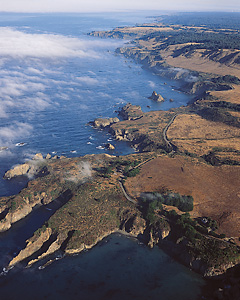

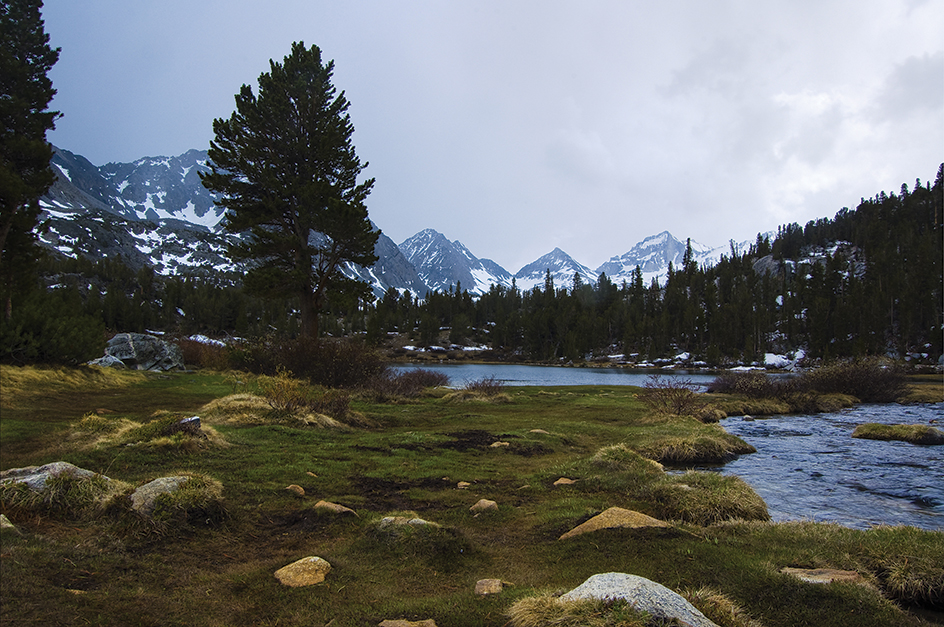
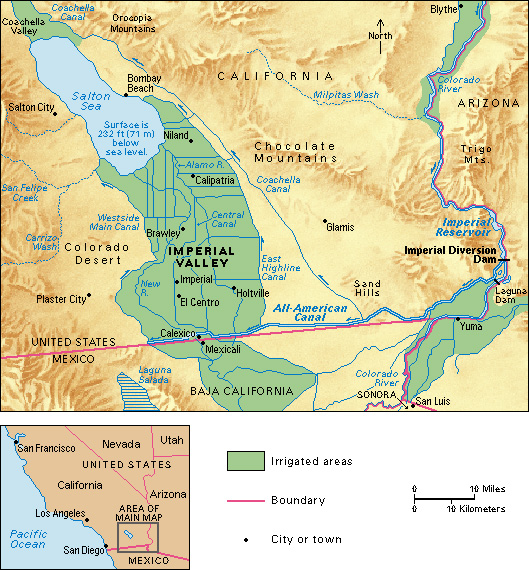
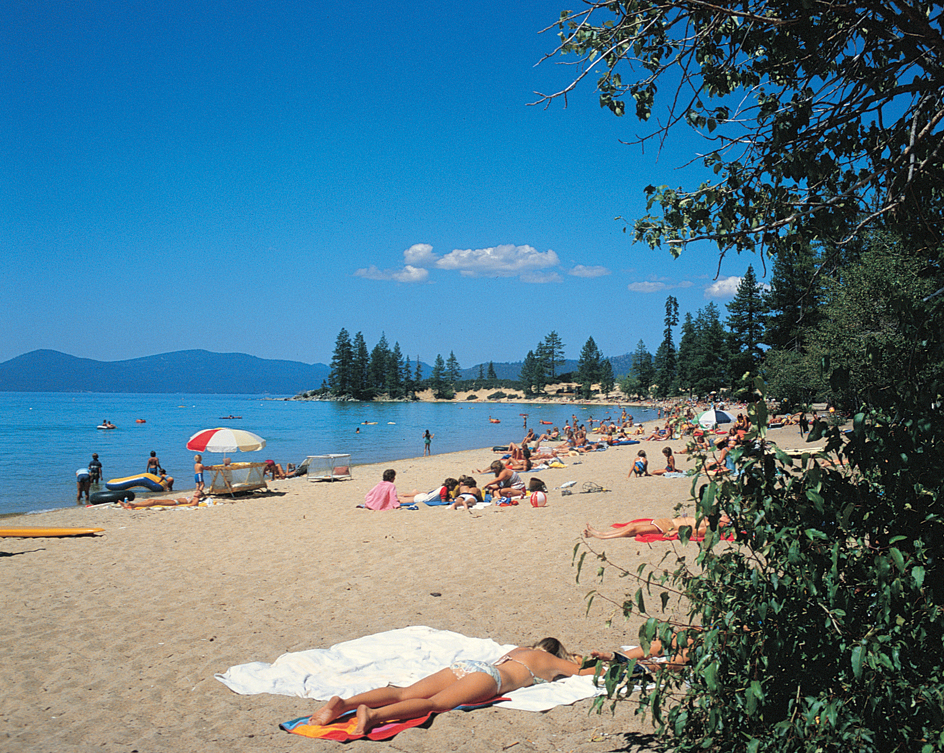
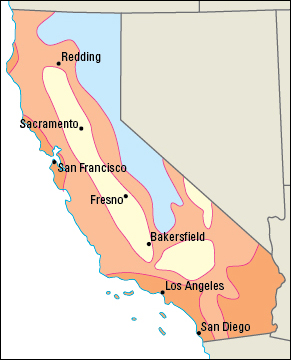
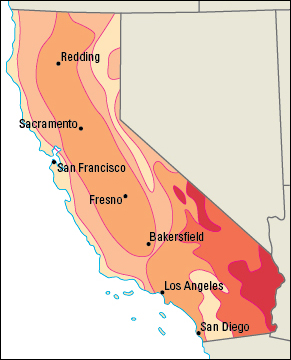
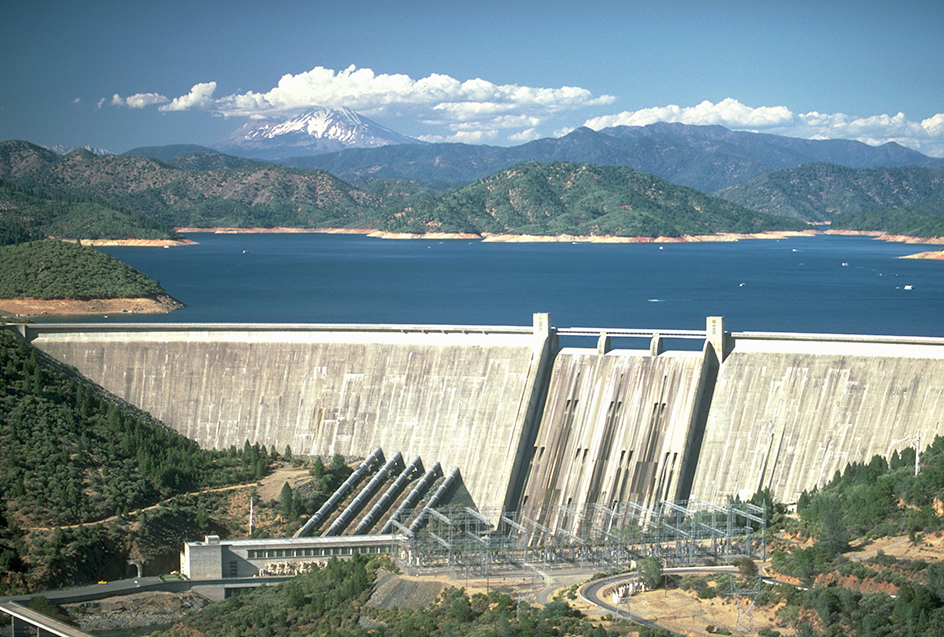
Land regions.
California has eight main land regions: (1) the Klamath Mountains, (2) the Coast Ranges, (3) the Central Valley, (4) the Sierra Nevada, (5) the Cascade Mountains, (6) the Basin and Range Region, (7) the Transverse Ranges, and (8) the Peninsular Ranges.
The Klamath Mountains
include several small, forest-covered ranges in the northwestern corner of California. These ranges are higher and more rugged than the coastal mountains to the south. Many peaks are from 6,000 to 8,000 feet (1,800 to 2,400 meters) high. Deep canyons break up the ranges.
The Coast Ranges
extend southward along the Pacific Coast from the Klamath Mountains to Santa Barbara County. Individual sections of this mountain chain have names of their own. These include the Diablo, Santa Cruz, and Santa Lucia ranges. Livestock ranches, orchards, vineyards, and truck gardens dot the beautiful valleys that separate the ranges. These valleys include the Napa Valley north of San Francisco, and the Santa Clara and Salinas valleys to the south. California’s famous redwood trees grow in the coastal areas of the Coast Ranges.
An important feature of the region is the San Andreas Fault. A fault is a break in the earth’s rocky outer shell, along which movements of the rock have taken place. The San Andreas Fault enters northern California from the Pacific Ocean near Point Arena and extends southeastward into southern California. Movements of the earth’s crust along this fault cause earthquakes. See San Andreas Fault.
The Central Valley,
sometimes called the Great Valley, lies between the Coast Ranges and the Sierra Nevada. It has two major river systems—the Sacramento in the north and the San Joaquin in the south. The valley extends about 450 miles (720 kilometers) from northwest to southeast. Much of it is level, and looks like a broad, open plain. This fertile valley forms the largest and most important farming area west of the Rocky Mountains. It has three-fifths of California’s farmland, and produces a great variety of crops.
The Sierra Nevada,
located east of the Central Valley, forms a massive rock wall more than 400 miles (640 kilometers) long and about 40 to 70 miles (64 to 110 kilometers) wide. Several peaks of the Sierra Nevada rise more than 14,000 feet (4,270 meters). These peaks include Mount Whitney (14,494 feet, or 4,418 meters), the highest point in the United States south of Alaska. Rushing mountain rivers have cut deep canyons in the western part of the Sierra. Yosemite Valley is the most outstanding of these canyons. Yosemite originally was cut by streams. Later, glaciers moved down the valley and eroded it further.
The Cascade Mountains
extend northward from the Sierra Nevada. Unlike other California ranges, the Cascades were formed by volcanoes. Lassen Peak (10,457 feet, or 3,187 meters) is an active volcano in the southern Cascades. Another famous peak, Mount Shasta (14,162 feet, or 4,317 meters), was once an active volcano.
The Basin and Range Region
is part of a larger region that extends into Nevada, Oregon, and several other states. It is an area of mountains and valleys created by movement along fault lines. Much of the northern section of the Basin and Range Region is a lava plateau called the Modoc Plateau. Thousands of years ago, lava flowed out of great cracks in the earth’s surface and flooded the area.
In southern California, much of the Basin and Range Region is a wasteland. South of the Garlock Fault lies the Mojave Desert. The Mojave covers a large area between the southern Sierra and the Colorado River. The Colorado Desert lies to the south. Irrigation has made several valleys in the region suitable for raising crops. These valleys include the fertile Imperial and Coachella valleys near the Mexican border. See Colorado Desert; Imperial Valley; Mojave Desert.
Death Valley is in the Basin and Range Region near the California-Nevada border. Part of Death Valley lies 282 feet (86 meters) below sea level and is the lowest point in North America. See Death Valley.
The Transverse Ranges,
also known as the Los Angeles Ranges, are a group of small mountain ranges between Santa Barbara and San Diego counties. They are called the Transverse Ranges because they extend generally in an east-west direction, along fault lines. Other ranges in California run generally north and south. The Transverse Ranges include the Santa Ynez, Santa Monica, San Gabriel, and San Bernardino mountains. Some geographers consider the San Jacinto and Santa Ana Mountains to be a part of this group. Most of the city of Los Angeles and its suburbs lie on a broad lowland between the San Gabriel Mountains and the Pacific Ocean. The hilly slopes of the Santa Monica Mountains extend into parts of the city.
The Peninsular Ranges,
also called the San Diego Ranges, cover most of San Diego County at the southwestern tip of the state. They include the Agua Tibia, Laguna, and Vallecito mountains. This mountain system extends southward into the Mexican peninsula known as Baja (Lower) California.
Coastline.
California’s general coastline measures 840 miles (1,352 kilometers). California’s tidal shoreline (including small bays and inlets) is 3,427 miles (5,515 kilometers) long. Along much of the coast, the Coast Ranges rise from the shore in steep cliffs and terraces. Southern California has many wide, sandy beaches. The California coast has two great natural harbors—San Francisco and San Diego bays. There are smaller natural harbors at Humboldt and Monterey bays.
Two groups of islands are located near the California coast. The small, rocky Farallon Islands rise from the ocean about 30 miles (48 kilometers) west of San Francisco. The eight Channel Islands lie scattered off the coast of southern California. Catalina Island, the best known of the Channel Islands, attracts many vacationers.
Rivers, waterfalls, and lakes.
California’s two longest rivers are the Sacramento and the San Joaquin. The Sacramento rises near Mount Shasta and flows south through the Central Valley. The San Joaquin rises in the Sierra Nevada and flows northwest through the Central Valley. The place where the two rivers meet is the Delta, a maze of channels and islands. Smaller rivers, such as the Feather and the Mokelumne, begin in the eastern mountains and flow west into the Sacramento or the San Joaquin.
The Colorado River forms the border between southern California and Arizona. It is an important source of water for Los Angeles and other cities of southern California. Water from the Colorado is also used to irrigate desert farmlands. Many rivers in southern California dry up or run underground during the dry season. Water may suddenly pour into the dry riverbeds during the rainy season and cause serious floods. In desert areas, most rivers have no outlets to other streams or to the sea. They flow above ground for a certain distance, then dry up or sink into the sand.
Yosemite National Park in California has several of the highest waterfalls in North America. Ribbon Falls (1,612 feet, or 491 meters) is the highest on the continent. Other high waterfalls in Yosemite include Bridalveil, Illilouette, Nevada, Silver Strand, Vernal, and Upper and Lower Yosemite.

California has about 8,000 lakes. Lake Tahoe, the deepest, averages 1,500 feet (427 meters) in depth. It lies in the Sierra on the California-Nevada border and reflects the surrounding mountain peaks. Most of the desert lakes east of the Sierra contain dissolved minerals that give the water a disagreeable taste. Potash, salt, and other minerals are taken from Owens Lake, Searles Lake, and other dry or partly dry lakes in this region. The Salton Sea is a large, shallow lake in southern California. It was formed between 1905 and 1907 by floodwaters from the Colorado River.
Plant and animal life.
California’s widely varied climate and terrain combine to produce a wide variety of plant and animal life. Some of the world’s most unusual living things are found in the state. The coast redwood tree is the tallest living thing in the world, and the bristlecone pine tree is the oldest. The rare California condor is the largest bird in North America.

Forests cover about 40 percent of California. Softwood trees make up most of the state’s forests. These trees include cedars, firs, hemlocks, giant sequoias, pines, and redwoods. The most common hardwood trees are oaks.
Desert plants cover much of the southeastern section of the state. These plants include burroweeds, creosote bushes, indigo bushes, Joshua trees, and several kinds of cactuses. Desert wildflowers include desert evening primrose and sand verbena. Patches of chaparral (thick and often thorny shrubs and small trees) cover the foothills. In the foothills and valleys of northern California, a spectacular array of wildflowers blooms after the winter rainy season. These flowers include beardtongues, the California poppy, evening primroses, fiddlenecks, and lupines. Fireweed and Washington lily bloom in the mountains.
Desert wildlife in California includes coyotes, lizards, and rattlesnakes. Beavers, bears, deer, foxes, minks, muskrats, rabbits, wild cats, wolverines, and a few mountain sheep roam the mountain and forest areas. Small herds of pronghorns and elk are found chiefly in the northern part of the state. California game birds include ducks, geese, grouse, mourning doves, quail, and turkey. Game fishes in the state’s streams include black bass, salmon, striped bass, and trout. Abalones, clams, crabs, shrimps, lobsters, oysters, scallops, and other shellfishes are found along the California coast.
Climate.
California has a great variety of climates. The southern coast has a mild climate. The climate along the coast of northern and central California is also mild, but this region is generally cooler than the southern coast. The climate of southeastern California is hot and dry. 
January temperatures in California average 49 °F (9 °C). Boca, near Truckee, recorded the state’s lowest temperature, – 45 °F (– 43 °C), on Jan. 20, 1937. July temperatures for the state average 74 °F (23 °C). The highest temperature ever recorded in the world, 134 °F (57 °C), occurred at Greenland Ranch in Death Valley on July 10, 1913.
Most parts of California have only two well-marked seasons—a rainy season and a dry season. The rainy season lasts from October to April in the north, and from November to March or April in the south. Yearly precipitation (rain, snow, and other forms of moisture) is greatest along the northern coast, where it averages over 80 inches (200 centimeters). At San Francisco, the yearly average is about 20 inches (51 centimeters); at Los Angeles, 13 inches (33 centimeters); and at San Diego, 10 inches (25 centimeters). Some desert basins in the southeast receive almost no rain. From Oct. 3, 1912, to Nov. 8, 1914, Bagdad, in Death Valley, had no measurable precipitation. This 760-day rainless period set a United States record.
Snowfall is rare along the central and southern coast of California. But at Tamarack, in the Sierra Nevada, the yearly snowfall averages about 450 inches (1,140 centimeters).
Economy
The value of California’s total economic production is higher than that of any other state. If California were a separate country, it would rank among the world’s 10 leading countries in total value of goods and services produced. California’s economy benefits from the state’s abundant resources and strategic location. Important resources include a mild climate, plentiful minerals and timber, and fertile soils. California’s location on the West Coast makes it a leading area for international trade with Asia and Latin America. California has long been a center of the motion-picture and television industries. Its films and entertainment products are distributed throughout the world.
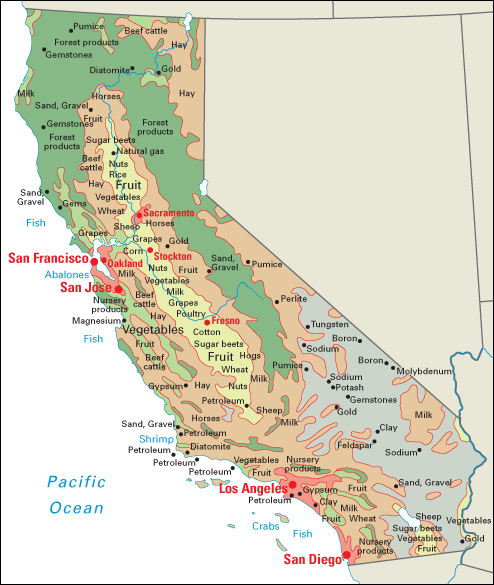
Service industries provide the largest portion of California’s gross domestic product—the total value of goods and services produced in the state annually. But goods-producing industries are also important.
California ranks first among the states in both agriculture and manufacturing. The Central Valley region is one of the world’s great farming areas. Most of the goods manufactured in California are products of modern science and engineering. These include airplanes, computers, electronic components, missiles, and scientific instruments. Private companies maintain several hundred laboratories in California for conducting research and testing new products. Most of these laboratories are located near large universities in the state. They are thus able to draw upon the ideas and skills of university biologists, chemists, engineers, and physicists.
Natural resources.
California is unusually rich in minerals and timber. The state’s soil and climate make it possible for farmers to grow a wide variety of crops.
Soils.
Many parts of California, especially in the Central Valley, have alluvial (water deposited) soils. These soils make the best farmland. The Imperial Valley in southern California has rich alluvial soils that produce outstanding crops when irrigated. Residual (upland) soils cover the mountain slopes. These soils support forests in areas that have enough rain. In many other places, they provide grazing land.
Minerals.
California has important fields of petroleum and natural gas in the southern part of the Central Valley, near the southern coast, and in coastal waters off Long Beach and Santa Barbara. Natural gas is also found in the Sacramento Valley. Valuable deposits of boron exist in southeastern California. Commercially important quantities of sand and gravel lie throughout California. Gemstones, including agate, benitoite, diamond, quartz, and tourmaline, are found in various counties. Other nonmetallic mined products found in the state include clays, diatomite, feldspar, gypsum, pumice, salt, soda ash, stone, and talc.
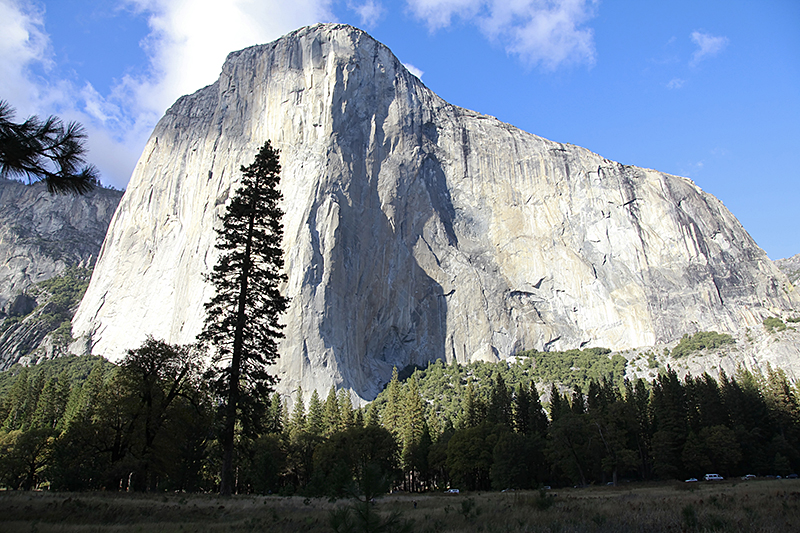
California’s tungsten deposits are among the nation’s largest. They occur mainly in Inyo County. Gold deposits are found in several parts of the state, from the western slopes of the northern Sierra Nevada to Imperial County, in the southeast.
Forests
cover about 40 percent of California. The state has two main timber regions, each named for an important tree in the region. The redwood region is a narrow belt that extends south along the coast from Oregon to San Luis Obispo County. The pine region covers the Cascades and the Sierra Nevada. It extends along the inland parts of the Klamath Mountains and the Coast Ranges as far south as Lake County. The Douglas-fir, which is one of California’s most valuable timber trees, grows in the redwood region and the pine region. Other important timber trees that grow in the state include incense-cedar, Jeffrey pine, ponderosa pine, red fir, sugar pine, redwood, and white fir.
California’s most famous trees are its two types of sequoias, the redwood and the giant sequoia. The redwood is the state tree. Redwoods are the world’s tallest living things. They grow near the coast in northern and central California. Giant sequoias, often called big trees, have larger trunks than redwoods but are not as tall. They grow on the western slopes of the Sierra Nevada. Bristlecone pines in the White Mountains of eastern California are the world’s oldest living things. Some are more than 4,000 years old. See Bristlecone pine.
California’s forests are important for timber production and for recreation. But they are especially important for preserving the state’s precious water supply. Water does not run off or evaporate so quickly in forest areas as it does in treeless regions. The logging industry and the government work to protect California’s forests from fire, harmful insects, and tree diseases. Landowners also grow trees on tree farms so there will be a constant supply of timber to replace the trees that are cut.
Water
is one of California’s most important natural resources. The mountain areas, especially in the north, have plenty of water from rain and melted snow. But most of California’s farms, industries, and homes are in the dry southern valleys. One of the state’s greatest problems is to transport water from rainy areas to dry places where it is needed. Many aqueducts (channels and large pipelines) and canals have been built for that purpose. The Owens Valley Aqueduct brings water from the east side of the Sierra Nevada to Los Angeles. Canals and aqueducts have long supplied water from the Colorado River to farms and cities in southern California. The Central Valley Project brings water from the Sacramento Valley to the San Joaquin Valley. The water is used to irrigate the state’s farms. The Hetch Hetchy Aqueduct brings water from the Tuolumne River to San Francisco.
The state’s largest water-transfer program is the California State Water Project. It includes dams and reservoirs to store water, and aqueducts to carry it from rivers in northern California to coastal cities and to southern California. Oroville Dam on the Feather River is the most important part of the project. Water from the Feather, Sacramento, and other northern rivers is sent southward in the long California Aqueduct. Some of the water is pumped over mountain ranges into the Los Angeles and San Diego areas.
Service industries
account for over four-fifths of both California’s employment and its gross domestic product. Service industries are most important in the state’s metropolitan areas, especially in the Los Angeles and San Francisco-Oakland areas. California’s service industries receive much income from tourism.
Finance, insurance, and real estate
is one of the fastest-growing economic activities in California. The San Francisco and Los Angeles areas are major United States financial centers. Several of the nation’s largest banking companies are based in San Francisco and Los Angeles. San Francisco is the headquarters of the Twelfth Federal Reserve District Bank, one of the 12 federal banks established by Congress. San Diego and San Jose are also major U.S. financial centers.
Community, business, and personal services
employs more people than any other activity in the state. Hollywood, considered the motion-picture capital of the world, is in California. Burbank is home to the Walt Disney Company, a major entertainment firm. Bechtel Corporation, one of the world’s leading engineering companies, has headquarters in California. 
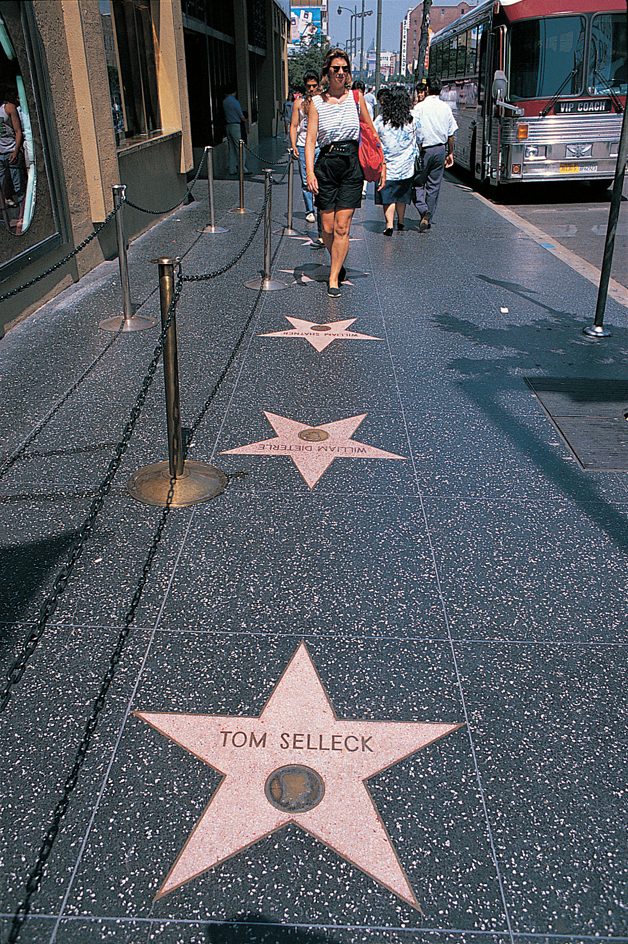
Trade, restaurants, and hotels.
Restaurants and hotels benefit from California having more tourists each year than any other state. Many hotels, restaurants, and retail trade establishments operate in the Los Angeles, San Diego, and San Francisco-Oakland areas. Safeway Inc., a major food store chain, is based in California.
Government
services include public schools and military establishments. California has one of the world’s largest public school systems, and its schools employ many people. Public universities in California operate many fine medical facilities and research laboratories. Edwards Air Force Base and several other Air Force bases lie within the state. California’s other military bases include Camp Pendleton and Naval Base Coronado. The military bases are an especially important part of the economy of the San Diego area. Sacramento, the state capital, is the center of state government activities.
Transportation, communication, and utilities.
Many shipping and trucking companies also operate in California. The airports in Los Angeles and San Francisco are among the world’s busiest. More information about transportation and communication appears later in this section.
Manufacturing.
California manufactures more goods than any other state. Many factories operate near San Jose and in the area between Los Angeles and San Diego. Chemicals, computer and electronic equipment, food products, refined petroleum, and transportation equipment are among the leading products.
Computer and electronic equipment
is one of the leading manufactured products. Computers, computer microchips, military communication equipment, and telephone equipment are the leading types of electronic products made in the state. Electronic systems for aircraft and missiles are important products. The San Jose area is the nation’s leader in the manufacture of electronic equipment. Silicon Valley, the leading computer-manufacturing region of the United States, is in this area. Apple Inc., Hewlett-Packard Company, and hundreds of other computer and electronics companies are headquartered there. Factories in Orange County and San Diego also produce large amounts of these goods. 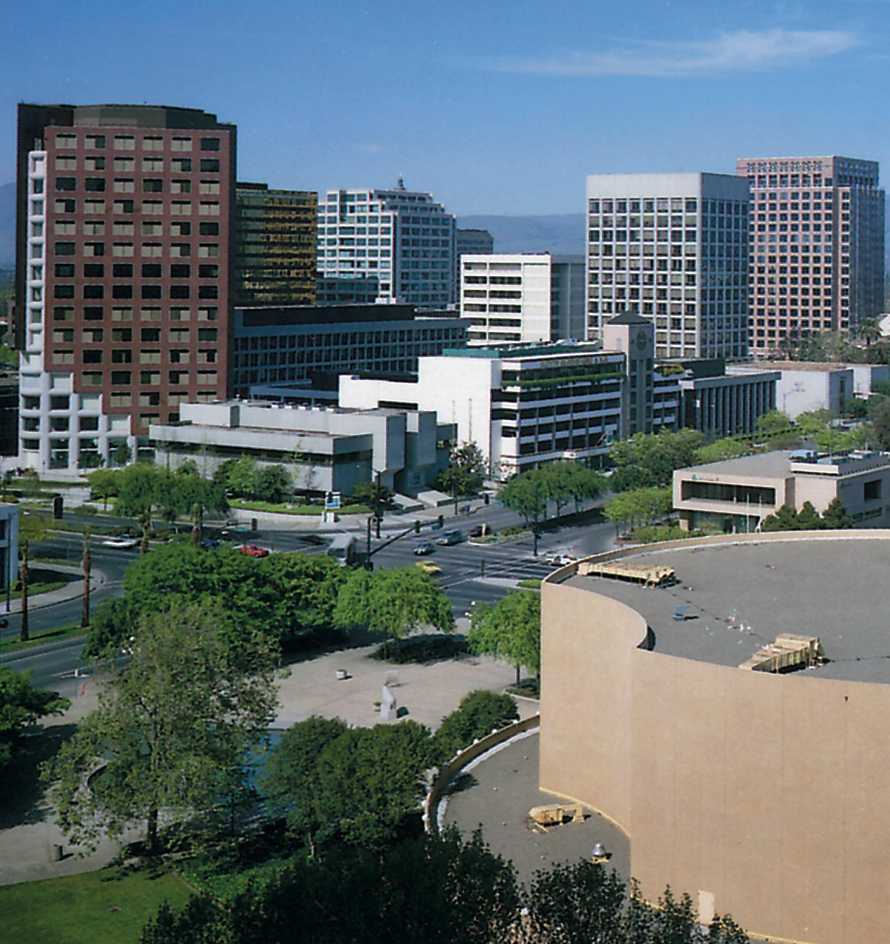
Chemicals.
Pharmaceuticals (medicinal drugs) are California’s leading chemical product. Other leading chemical products include adhesives, cleaning compounds, and paints. Many chemical products are manufactured in the Los Angeles, San Diego, and San Francisco areas.
Food processing.
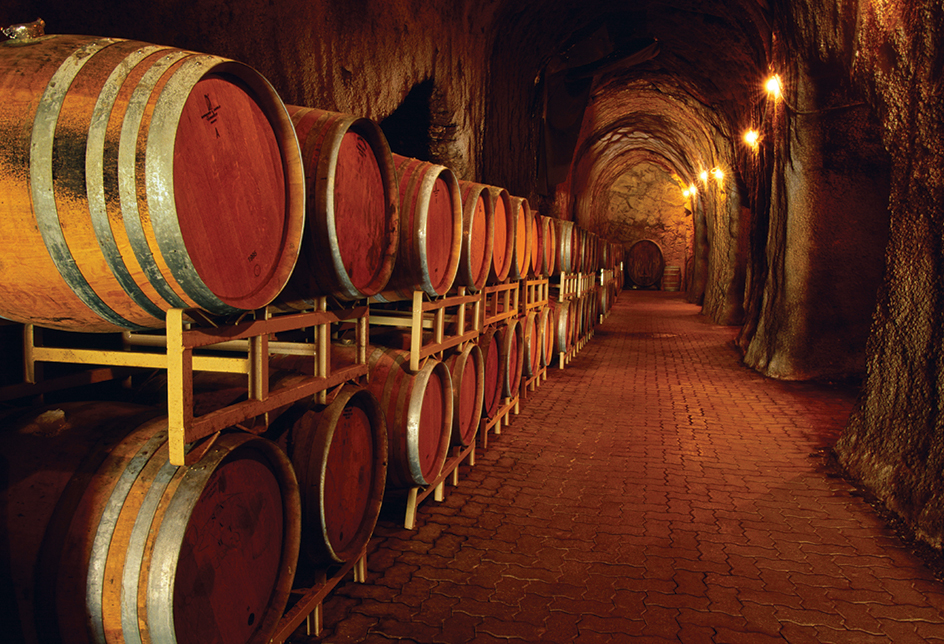
Petroleum products.
California is a top petroleum-refining state. El Segundo, Los Angeles, Martinez, Richmond, and Torrance have large petroleum refineries.
Transportation equipment.
Aircraft are the state’s most important type of transportation equipment. Southern California is a leading aircraft assembly center. California’s largest aircraft manufacturers include the Boeing Company and Northrop Grumman Corporation. Other types of transportation equipment made in the state include motor vehicles and motor vehicle parts.
Agriculture.
California leads the states in farm income. Fresno, Kern, Merced, Monterey, San Joaquin, Stanislaus, and Tulare counties are among the nation’s top-ranking counties in agricultural production. Many Californians call farms ranches, even if the farms raise crops rather than livestock.
The wide range of climate and of soil and water conditions enables California farmers to grow hundreds of different crops. Several of these crops are grown commercially nowhere else in the nation. Most California farms are highly specialized. Many specialize in fruits or nuts. Almost all crop production takes place on farmlands that receive irrigation water.
Fruits and nuts.
Grapes are the state’s most valuable fruit, and California is the leading grape-producing state. The grape crop includes table grapes, wine grapes, and raisin grapes. California produces almost all of the nation’s almonds, figs, kiwi fruit, olives, pistachios, pomegranates, prunes, and walnuts. California also leads all states in the production of apricots, avocados, dates, lemons, nectarines, peaches, plums, raspberries, and strawberries. The state is a leading producer of oranges.
Various regions of California specialize in fruits and nuts for which their soil and climate are best suited. For example, the San Joaquin Valley grows almonds, apricots, cantaloupes, grapes, nectarines, oranges, peaches, pistachios, plums, and walnuts. The Sacramento Valley yields pears and prunes. Southern coastal counties lead in the production of avocados and have a heavy production of strawberries. Farms in the Imperial Valley yield dates, grapefruits, and melons.
Vegetables.
Lettuce and tomatoes are the most important vegetable crops in the state. California ranks first in the production of both lettuce and tomatoes. Lettuce is cultivated primarily in the southern part of the state and in the regions that lie between Fresno and Monterey. The most important tomato-growing region is the San Joaquin Valley. California also leads the nation in the production of artichokes, asparagus, bell peppers, broccoli, Brussels sprouts, carrots, cauliflower, celery, garlic, onions, and spinach. 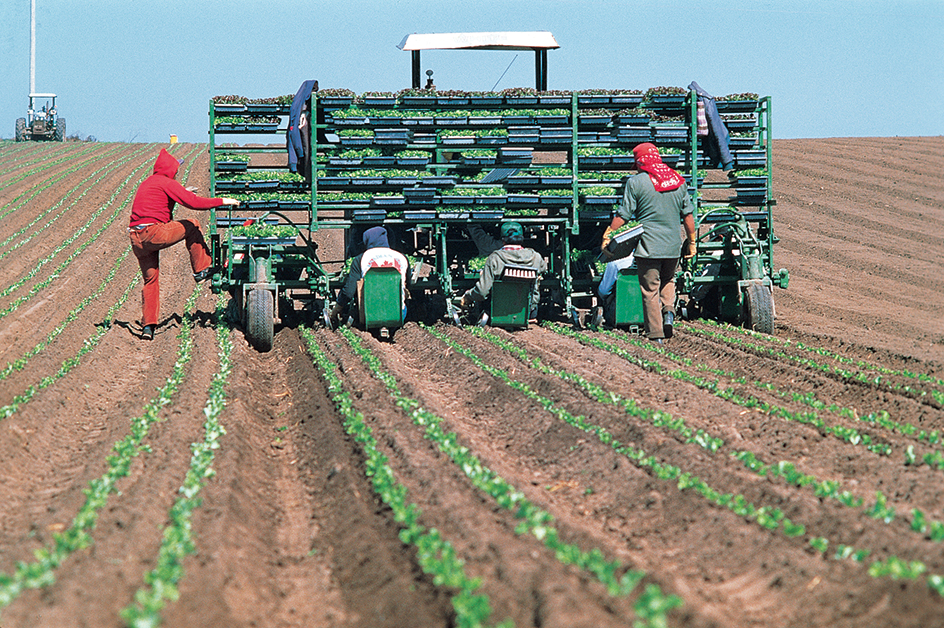
Field crops.
Cotton and hay are California’s leading field crops. California’s San Joaquin Valley is a major cotton-growing region. California is the leading hay producing state. Farmers grow rice in the Sacramento Valley.
Greenhouse and nursery products.
California produces more greenhouse and nursery products than any other state. It leads all states in the production of cut flowers, potted flowering plants, and flower bulbs. Most greenhouse and nursery products are grown in coastal areas between San Francisco and San Diego.
Livestock and livestock products.
Milk is California’s leading agricultural product. California leads the states in milk production. Dairy cattle are chiefly raised in the San Joaquin Valley. Beef cattle are another leading agricultural product in the state. Many beef cattle come from the Sacramento and San Joaquin valleys. California ranks among the leaders in egg production, and in raising sheep and turkeys. California is also a leading honey-producing state.
Mining.
Petroleum is California’s most valuable mined product. Most oil wells are in Kern County and the Los Angeles area. Much natural gas comes from the petroleum-producing regions and from the Sacramento Valley.
California is a leading state in nonfuel mineral production. California mines yield all of the boron that is produced in the United States. Boron comes from Inyo, Kern, and San Bernardino counties. It is used in boric acid, an antiseptic; in borax, a cleaning agent; and in making glass fibers for such products as insulation and textiles. California is also the leading U.S. producer of sand and gravel. California is among the leading states in the production of feldspar, gemstones, gypsum, magnesium compounds, portland cement, and pumice.
Fishing industry.
Crabs and squids are the most valuable fish catches in the state. California is a leading catcher of both crab and squids. Other important seafood catches include halibut, lobster, oysters, rockfish, sablefish, sardines, sea urchins, shrimp, sole, swordfish, and tuna.
Electric power and utilities.
Much of California’s electric power comes from plants that burn natural gas. Hydroelectric plants and nuclear plants produce much of the remaining electric power. Hoover, Davis, Glen Canyon, and Parker dams on the Colorado River supply power to California as well as to other southwestern states. Power companies also generate power from many dams on rivers in northern California.
Electric power produced by geothermal, solar, and wind sources is of increasing importance in the state. The Geysers Geothermal Field near Healdsburg is one of the nation’s few commercial electric plants powered by geothermal steam—steam created by heat deep in the earth. In 1983, what was then the world’s largest solar power plant began operation near San Luis Obispo. It produced electric power from sunlight.
Transportation.
California’s first highway, El Camino Real, began as a path connecting the Spanish missions along the coast during the 1700’s. The state’s first major freeway, the Arroyo Seco Parkway (now Pasadena Freeway) between Pasadena and Los Angeles, was completed in 1940. Today, the state has an extensive system of roads and highways. Complicated freeway systems, with underpasses, overpasses, and cloverleafs, are a familiar symbol of California’s urban areas.
San Francisco Bay has two of the most famous bridges in the world. These are the Golden Gate Bridge between San Francisco and Marin County and the San Francisco-Oakland Bay Bridge. Another important bridge, the Richmond-San Rafael Bridge, crosses a northern section of San Francisco Bay. 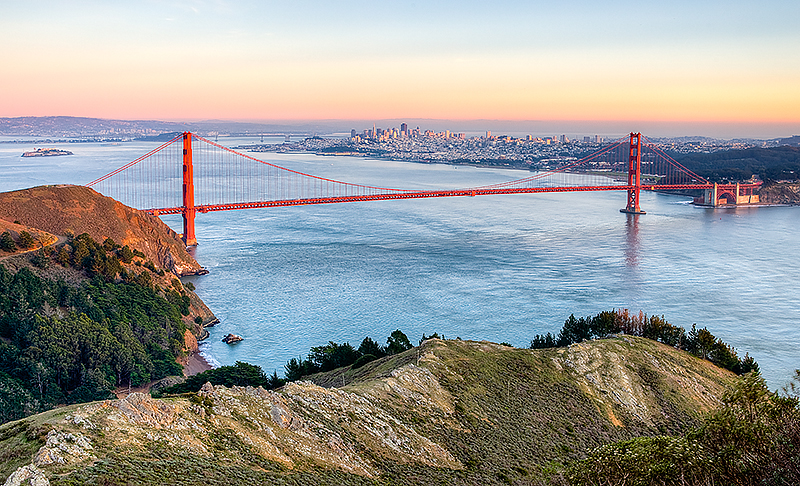
The international airports at Los Angeles and San Francisco are among the world’s busiest. Other major airports include those in Oakland, Orange County, Sacramento, San Diego, and San Jose.
California’s first railway, completed in 1856, ran 22 miles (35 kilometers) between Sacramento and Folsom. Today, rail lines provide freight service on thousands of miles of track.
Southern California has major ports at Long Beach, Los Angeles (San Pedro), and San Diego. The San Francisco Bay area has several deepwater ports that ship millions of tons of goods each year. Besides San Francisco itself, these ports include Oakland, Redwood City, and Richmond. Sacramento and Stockton are important inland ports. They handle shipments of agricultural and mineral products from the Sacramento and San Joaquin valleys. Deepwater channels connect the Sacramento and Stockton ports with San Francisco Bay.
Communication.
California’s first newspaper, the Californian, began publication in Monterey in 1846. Today, the state has several hundred newspapers, many of them dailies. California’s leading papers include The Fresno Bee, the Los Angeles Times, The Orange County Register, The Press-Enterprise of Riverside, The Sacramento Bee, The San Diego Union-Tribune, the San Francisco Chronicle, and the San Jose Mercury News.
Government
Constitution.
California’s first constitution was adopted by the territorial government in 1849. The present constitution was adopted in 1879. It has been amended (changed) hundreds of times. A proposed amendment must be placed on the ballot in a regular statewide election. It may be proposed and placed on the ballot in any of three ways: (1) The Legislature may propose it by a two-thirds majority vote in each house. (2) A group of citizens may propose an amendment by submitting a petition. The petition must be signed by at least 8 percent as many people as voted for governor in the last election. (3) A constitutional convention, approved by two-thirds of the Legislature, may propose an amendment. To become law, an amendment must be approved by a majority of the voters.
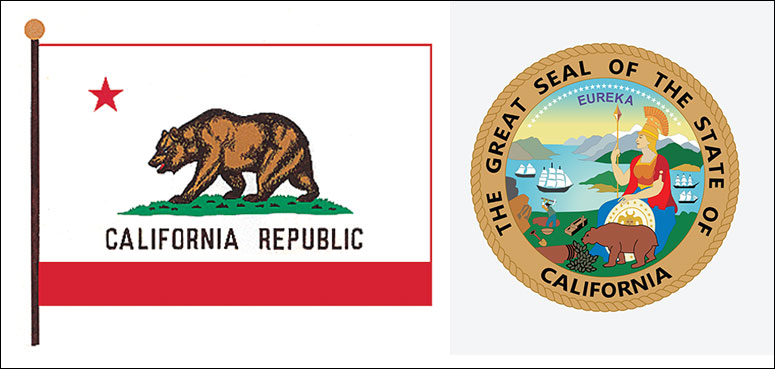
Executive.
Voters elect California’s governor to a four-year term. The governor can serve only two terms.
Other top state officials include the lieutenant governor, secretary of state, attorney general, treasurer, controller, insurance commissioner, and superintendent of public instruction. Voters also elect the members of the State Board of Equalization, which administers several important tax laws. All these officials are elected to four-year terms and may serve no more than two terms in the same office.
Legislature
consists of a Senate of 40 members and an Assembly of 80 members. Each senator and each Assembly member represents one senatorial or Assembly district. Senators are elected to four-year terms and may serve only two terms. Members of the Assembly are elected to two-year terms and may serve no more than three terms. 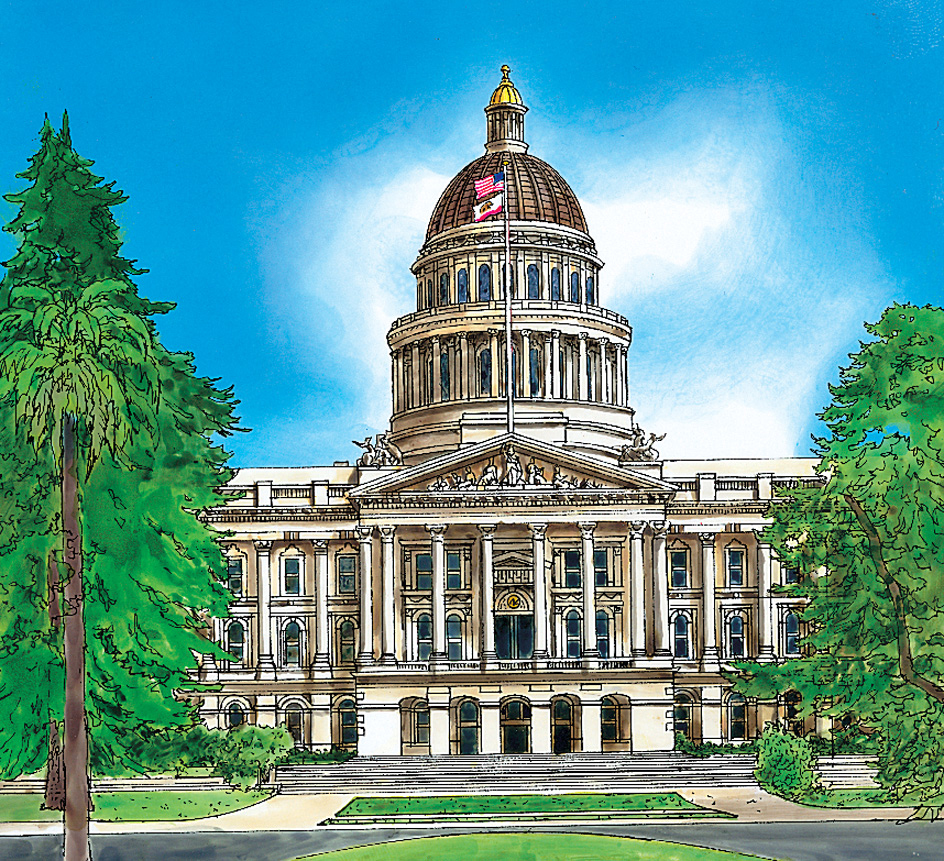

Regular sessions of the Legislature run about two years. They begin on the first Monday in December of each even-numbered year and end on November 30 of the next even-numbered year.
The governor may call special sessions at which the Legislature can deal only with subjects specified by the governor. There is no time limit on special sessions of the Legislature.
California citizens can pass laws directly, through their power of initiative. To do so, a proposed law must be favored by at least 5 percent of the people who voted for governor in the last election. This number of people must sign a petition in favor of a measure. Then they can put the measure on the ballot in the next state election. If the voters approve the measure, it becomes law.
In a process called the referendum, Californians also have the right to challenge most kinds of laws passed by the Legislature. If 5 percent of the people who voted for governor in the most recent election challenge a new law, the law will not go into effect unless the people approve it in an election.
Courts.
The highest court in California is the state Supreme Court. It has a chief justice and six associate justices. The state has six district courts of appeal. Justices of the Supreme Court and of the district courts of appeal are appointed by the governor to 12-year terms, subject to voter approval.
Each county has one superior court. The number of judges for each superior court is fixed by the Legislature. The voters elect superior court judges to six-year terms.
Local government.
California has several hundred incorporated cities. The state Constitution gives cities the right to draw up and adopt their own charters. This right is often called home rule. More than 100 California cities operate under local charters.
Most of the cities in California have council-manager governments. The others have mayor-council governments.
California has 58 counties. Most of the counties have a form of government specified by the laws of the state. This form of government includes a board of supervisors and a number of elected executive officials. The elected officials include an assessor, auditor, clerk, coroner, district attorney, sheriff, superintendent of schools, and treasurer. The California Constitution provides for county home rule. Home rule laws allow a county to choose the form of government best suited to its needs. Most of these counties chose a form of government similar to that of the general-law counties.
Revenue.
Taxation provides over half of the state’s general revenue (income). Most of the rest of its revenue comes from federal government grants. The largest sources of state tax revenue are a personal income tax and a general sales tax. Other important tax revenue sources include taxes on corporate profits, motor fuels, and property, and licenses for businesses and motor vehicles.
Politics.
Until 1959, California did not require political candidates to declare their party affiliation. For example, they could run as candidates of both the Democratic and Republican parties. This practice, known as cross-filing, kept many voters from being loyal to one particular party. As a result, political disagreements between various parts of the state tended to be stronger than disagreements among the parties themselves. Major political conflicts still occur between northern and southern California. In 1965, southern California gained political power when reapportionment of the Legislature gave the area more seats in the state Senate.
History
Early days.
As many as 300,000 Native Americans lived in the fertile parts of the California region before Europeans arrived. There were many tribes, and they spoke different languages. Deserts and high mountains often separated the Indigenous groups in California from one another and from the tribes farther east. The Hupa people lived in the far northwestern part of what is now California. The Maidu lived in the central section, and the Quechan lived in the south. The Pomo people occupied the territory that now makes up Lake, Mendocino, and Sonoma counties north of San Francisco. Other Indigenous groups in the California region included the Miwok, Modoc, and Mojave tribes.
Spanish and English exploration.
Juan Rodríguez Cabrillo, a Portuguese explorer employed by Spain, was the first European to see the coast of what is now California. In 1542, Cabrillo sailed north from New Spain (present-day Mexico) along the Pacific Coast. He hoped to find rich cities and a water passage between the Pacific and Atlantic oceans. Cabrillo discovered San Diego Bay and stopped there before sailing farther north. Cabrillo died in 1543, but his men continued the voyage. Some historians believe that Cabrillo’s expedition sailed along the entire California coast, as far north as present-day Oregon.
In 1579, Francis Drake, an English sea captain, followed a route along the California coast during his famous voyage around the world. Drake claimed the land for England and named it New Albion. The Spaniards then sent several exploring parties along the coast, partly because they feared they might lose California to the English. In 1602, Sebastián Vizcaíno led one of these expeditions. He named many landmarks along the coast, and sent an enthusiastic report about California to the king of Spain. In the report, Vizcaíno urged that Spain colonize California.
Spanish and Russian settlement.
Beginning in 1697, the Spaniards established missions and other settlements in Baja (Lower) California, the Mexican peninsula south of present-day California. Captain Gaspar de Portolá, governor of Baja California, led an expedition that established the first presidio (military fort) at San Diego in 1769. He also established one at Monterey in 1770. In 1776, a group of Spanish settlers arrived at the site of what is now San Francisco. The settlers founded a presidio and a mission there. Later, other groups of settlers sent by Spain established some pueblos (villages) near the coast.
However, Spain did not have a strong hold on the California region. Russia had fur-trading interests in Alaska, and wanted to search for furs farther south along the Pacific Coast. In 1812, the Russians established Fort Ross on the northern California coast. Russian activity in California was one reason for the Monroe Doctrine, proclaimed in 1823. In the Monroe Doctrine, the United States declared that North and South America should be considered closed to European colonization. In 1824, Russia agreed to limit its settlements to Alaska. However, the Russians did not actually leave the California region until the early 1840’s.
The California missions.
Franciscan friars of the Roman Catholic Church played an important part in the Spanish settlement of California. In 1769, during the Portolá expedition, Junípero Serra established the first California mission. This mission was San Diego de Alcalá, originally established in what is now San Diego. By 1823, the Franciscans had built a chain of 21 missions. Each mission was about a day’s walk from the next. Many Indigenous people who lived near the missions were forced to farm, weave, and perform other tasks for the friars and the local communities. A number of Indigenous people were exposed to new diseases. Many became ill and died. 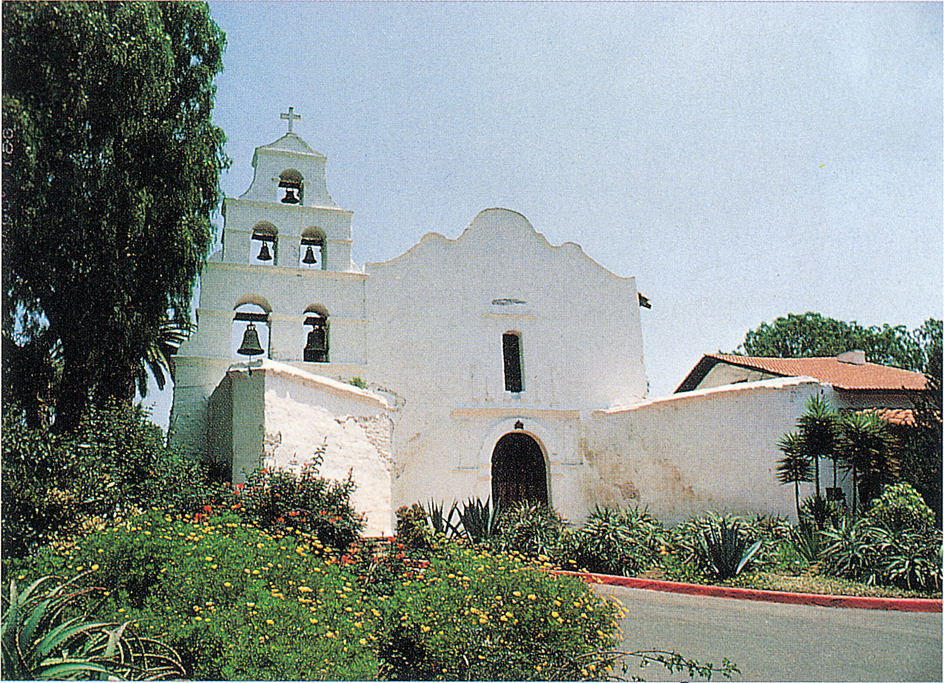

Many people in California and Mexico wanted the missions broken up. In the early 1830’s, the government began giving mission land to private citizens. By 1846, almost all the mission property had been given away. During this period, the government gave or sold many large estates, called ranchos, to private landowners, called rancheros. Some rancheros became wealthy by raising cattle for hides and tallow (fat used in making candles, soap, and other products).
Mexican rule.
California became a province of Mexico in 1822, after Mexico won its independence from Spain. The province set up its own legislature and established a military force. But, beginning in 1825, Mexico sent a series of governors to California. Many Californians rebelled against having their affairs dictated by these outsiders. Manuel Victoria, who became governor in 1831, ruled with a strong hand and was especially resented by the Californians. A group led by Pío Pico and others clashed with Mexican government troops in 1831. This fighting was not severe. But the continuing opposition forced Victoria to give up the governorship and return to Mexico City. After that, Mexico’s control over the region remained weak. 
American settlement.
The Otter, the first American sailing vessel to reach the coast from the East, appeared in California waters in 1796. After that, American skippers made many trading trips to harbors along the coast of California.
The first American explorer to reach California by land was Jedediah Strong Smith, a trapper who crossed the southwestern deserts in 1826. Other trappers and explorers followed Smith. They included Kit Carson, Joseph Reddeford Walker, and Ewing Young.
In 1841, the first organized group of American settlers came to California by land. These settlers were led by John Bidwell, a schoolteacher, and John Bartleson, a wagon master and land speculator. Soon other overland pioneers arrived to settle in the Mexican territory. They drove long wagon trains through the mountain passes. The new settlers wanted California to become a part of the United States. The United States offered to buy the land from Mexico, but Mexico refused to sell.
The Mexican War.
Between 1844 and 1846, the military explorer John C. Frémont led two surveying parties into California. The Mexicans did not trust Frémont because his parties were made up of U.S. soldiers. In March 1846, the Mexicans ordered Frémont to withdraw his troops, who were camped near Monterey. Instead, Frémont raised the U.S. flag over Hawk’s Peak, about 25 miles (40 kilometers) from Monterey. He began to build a fort there. Fighting was avoided when Frémont withdrew to the north under cover of darkness. On May 13, 1846, the United States and Mexico went to war (see Mexican War).
In June 1846, without knowing that war had been declared, a band of American settlers took over Sonoma, Mexico’s headquarters in northern California. The group was led by frontiersman Ezekiel Merritt. After capturing the fort, the settlers unfurled a homemade flag bearing a star, a grizzly bear, and the words California Republic. This action became known as the Bear Flag Revolt. 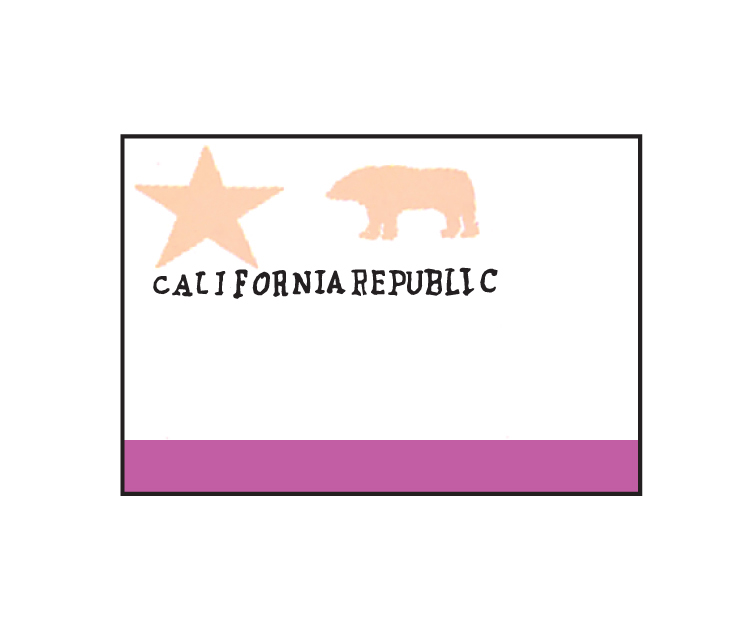
The real conquest of California was carried out by United States soldiers, sailors, and marines. They were led by Frémont, Commodore Robert F. Stockton, and General Stephen W. Kearny. After the United States won the Mexican War in 1848, Mexico surrendered its claim to California in the Treaty of Guadalupe Hidalgo. California then became part of the United States.
The gold rush.
In 1848, just before the United States and Mexico signed the peace treaty, gold was discovered in California. John A. Sutter, a pioneer trader, had received a large land grant in the Sacramento Valley in 1839. He hired James W. Marshall, a carpenter, to help build a sawmill on the American River. There, at Sutter’s Mill, Marshall found the first gold nuggets. News of his discovery spread, and thousands of persons rushed to establish claims. These “Forty-Niners,” as they were called, poured in from all parts of the world. Between early 1848 and the end of 1849, California’s population increased from about 15,000 to more than 100,000. The free spending by the miners who found gold made such communities as San Francisco and Sacramento into flourishing towns. Some miners who were not so lucky in the gold fields became farmers and ranchers in the Central Valley. See Forty-Niners; Gold rush. 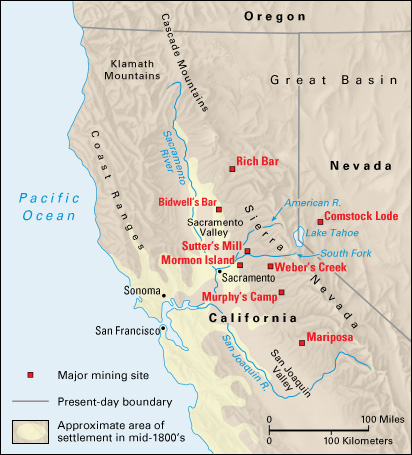

Early statehood.
California became the 31st state on Sept. 9, 1850. Peter H. Burnett, a Democrat, was the first state governor. Thousands of settlers went west after the American Civil War ended in 1865. They sought the high wages paid in California and a chance to buy land at low prices. In 1869, the first transcontinental railroad system linked Sacramento with the eastern United States. Part of this system, the Central Pacific Railroad, later became part of the Southern Pacific, owned by Charles Crocker, Mark Hopkins, Collis P. Huntington, and Leland Stanford. These men were known as California’s “Big Four.” They brought many Chinese laborers to California in the 1860’s to work on the railroads. 
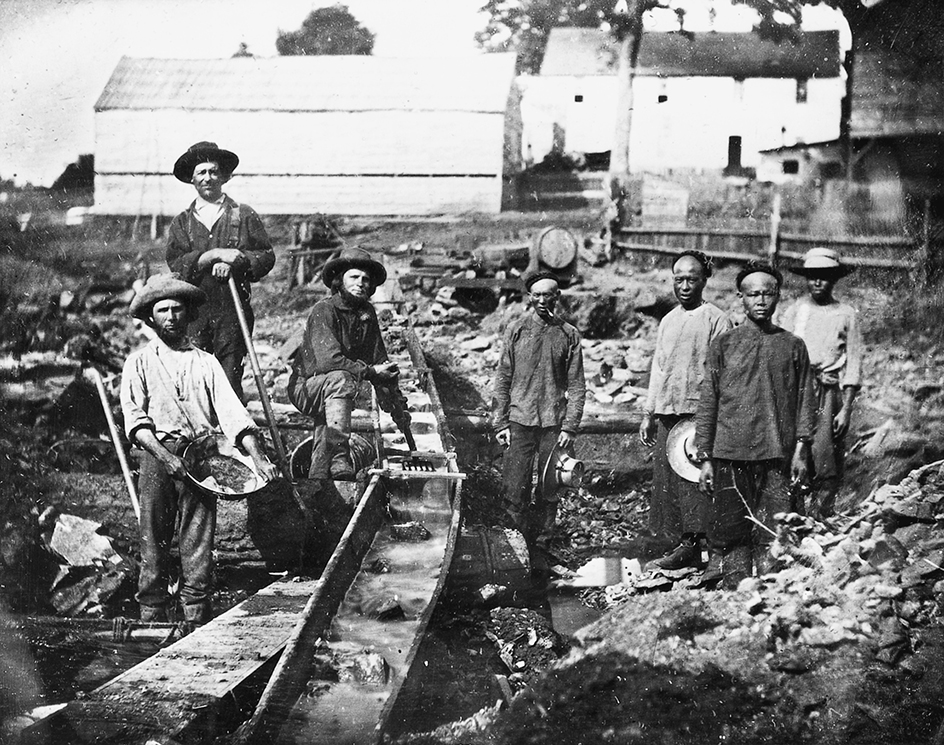
By 1870, California’s population had risen to about 560,000. During the next 10 years, a depression caused widespread unemployment and bank failures. Many unemployed workers blamed their troubles on Chinese laborers, who were willing to work for low wages. Anti-Chinese riots took place in Los Angeles in 1871 and in San Francisco in 1877. During the 1880’s, a great publicity campaign brought thousands of people to California. So many came to southern California in 1887 that a land boom occurred. Agriculture and industry flourished as the population increased.
In 1906, a terrible earthquake in San Francisco destroyed about 28,000 buildings and killed more than 3,000 people. However, the city was soon rebuilt. 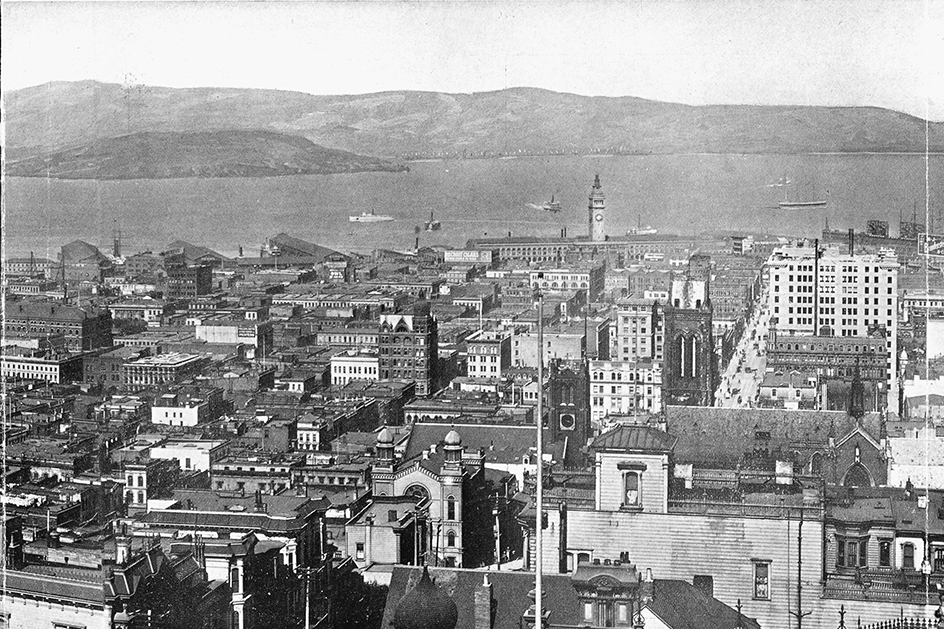
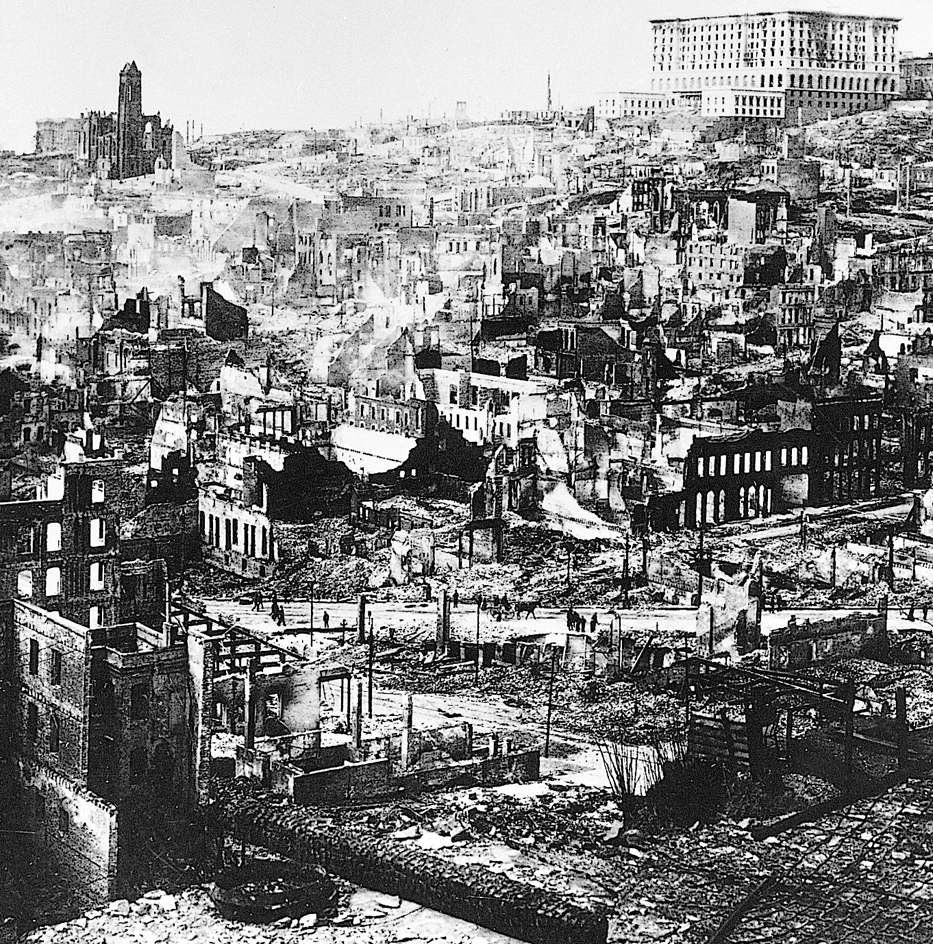
Progress as a state.
During the early 1900’s, California grew rapidly in population and in the development of natural resources. Mexican immigration soared after a revolution in Mexico in 1910. Farming increased greatly after irrigation turned many desert areas into fertile land. Development of oil and natural gas was accompanied by the growth of new industries. Other minerals besides gold were found, and mining became more important. By 1920, Hollywood had become the motion-picture capital of the world.
In 1910, Californians elected Hiram W. Johnson as governor. Two years later, Johnson joined Theodore Roosevelt in a revolt against the Republican Party. Johnson ran for U.S. vice president under Roosevelt in 1912 on the unsuccessful Progressive Party ticket.
In 1914, the completion of the Panama Canal shortened the important sea route between California and the East. To show the value of the canal to California, the state sponsored the Panama-Pacific International Exposition in San Francisco in 1915 and the Panama-California Exposition in San Diego in 1915 and 1916.
After the United States entered World War I in 1917, shipyards, rubber plants, and other factories were established in California. After the war ended in 1918, interest turned to control of the Colorado River. This mighty river had caused serious flood damage for many years. Between 1905 and 1907, floodwaters from the Colorado had even formed the 450-square-mile (1,165-square-kilometer) Salton Sea in southeastern California. In 1928, Congress authorized a huge dam at Boulder Canyon on the Arizona-Nevada border. The dam, now called Hoover Dam, was completed in 1935. It controls floods and provides water for irrigation and power in southern California and neighboring states (see Hoover Dam).
During the Great Depression of the 1930’s, hundreds of people without homes or jobs drifted into California. The state passed laws to close its borders to poor people. But this legislation was later declared unconstitutional by the Supreme Court of the United States. Many Californians blamed the Depression on Mexican Americans, and the state deported hundreds of thousands of Mexican Americans to Mexico.
In 1935 and 1936, the California-Pacific International Exposition was held in San Diego. This fair honored the Pacific Ocean and the countries that border it. The Golden Gate International Exposition was held in 1939 and 1940 on Treasure Island in San Francisco Bay. The Golden Gate Bridge across the entrance to the bay had been completed in 1937.
The mid-1900’s.
During World War II (1939-1945), California produced airplanes, ships, and weapons. The state became the nation’s aircraft center. After Japan attacked Pearl Harbor in 1941, the government moved thousands of Japanese Americans from California to detention camps (see World War II (On the home front)). In 1945, representatives of 50 nations approved the United Nations Charter at the San Francisco Conference.
Many people who had come to California as members of the armed forces or to work in defense plants settled there after the war. The population soared. Farm centers became metropolitan areas with a variety of industries. Rows of ranch-style houses appeared on former orchards and pastures. New freeways linked smaller cities with Los Angeles and San Francisco.
The population growth boosted California’s economy, but it also created problems. The state had to provide more schools and highways. Smog became a serious problem in Los Angeles and other cities as more automobiles and industries discharged fumes and smoke.
Changes in U.S. immigration laws in 1965, which ended quotas based on nationality, led to another increase in California’s population. Hundreds of thousands of people from Asia countries settled in the state.
Controlling and distributing water resources remained California’s biggest problem during the 1960’s. Most of the state’s rain and snow falls in the northern mountains. But most of California’s people live in southern California, where rainfall does not supply enough water. In the 1960’s and early 1970’s, the state built a system of canals, dams, reservoirs, and power and pumping plants to store and distribute northern California’s excess water to the drier areas. A number of additions to the system have been completed since the 1970’s.
In the 1950’s and 1960’s, African Americans, Asian Americans, and Mexican Americans began to demand equal rights. Racial tensions worsened in 1964 after California voters passed a referendum that overturned a 1963 law guaranteeing equal access to housing. In 1965, racial violence erupted in Watts, a Black section of Los Angeles. Rioting broke out after a Los Angeles police officer arrested a Black motorist. It resulted in the deaths of 34 people and millions of dollars of damage.
By the end of the 1960’s, California had greatly increased its number of state universities and colleges. The state’s schools became the center of various student movements. The nation’s first major college demonstration, organized by the Free Speech Movement, occurred in 1964 at the University of California in Berkeley.
Richard M. Nixon, born in Yorba Linda, was elected president of the United States in 1968 and was reelected in 1972. He resigned from the office in 1974 because of his involvement in the Watergate political scandal.
Motion-picture stars gained popularity with California voters in the 1960’s. George L. Murphy won election to the U.S. Senate in 1964, and Ronald Reagan became governor in 1967. Reagan was elected president of the United States in 1980 and was reelected in 1984.
The late 1900’s.
In the early 1970’s, sharp cuts in federal military spending in California caused a rise in unemployment. In 1978, California voters approved a referendum—known as Proposition 13—that called for a $7-billion reduction in state property taxes. School districts and local government suffered revenue losses.
By the early 1980’s, however, California’s economy was thriving again. Education and other services benefited from the state’s increased revenues. New federal military contracts helped bring prosperity to California’s aerospace industry. In addition, Santa Clara County became a world leader in the production of high-technology electronic equipment. It earned the name Silicon Valley.
On Oct. 17, 1989, a strong earthquake struck the San Francisco-Oakland-San Jose area. It caused 63 deaths and extensive property damage. Most deaths were caused by the collapse of a section of the Nimitz Freeway in Oakland. In 1991, a major brush fire struck Oakland and surrounding areas. It caused 25 deaths and destroyed much property. In 1993, a series of brush fires near Los Angeles killed 4 people and caused heavy property damage. In January 1994, another extremely destructive earthquake struck Los Angeles. It caused 57 deaths and much property damage. 
In 1992, four police officers who were accused of a 1991 beating of a Black motorist, Rodney G. King, were acquitted of criminal charges. The verdict set off several days of rioting, mainly in Black areas of South Los Angeles (then called South-Central Los Angeles). The rioting resulted in 53 deaths and about $1 billion in property damage.
The state’s population continued to grow rapidly, partly because of the large numbers of immigrants from Europe, Asia, and especially Central America and Mexico. In 1986, California voters approved a referendum to make English the state’s official language. In 1994, the voters passed a referendum to prohibit illegal immigrants from receiving public education, free nonemergency medical care, and other social services. But implementation was blocked by a number of lawsuits. In 1999, the state abandoned the proposition. Governor Gray Davis said that much of the intent of the proposition was covered by federal immigration laws passed in 1996 that deny certain social services to illegal immigrants.
The 2000’s.
California’s ample natural resources and reputation for innovation helped the state maintain its position as one of the world’s leading economies during the 2000’s. Such environmental challenges as wildfire and drought, however, continued to pose major challenges to the Golden State.
Rolling blackouts.
Power outages, called “rolling blackouts,” became common across the state in 2001. The energy crisis stemmed in part from actions taken in 1996, when the state had approved legislation to deregulate its utility industry. Government officials had believed that such action would increase competition among electric companies and reduce rates for customers. But by 2000, the state’s electric companies faced financial ruin. They had to pay increasingly high wholesale costs for electric power, but the deregulation law prevented them from raising the costs to customers. In mid-2001, the state stepped in to buy power for the financially weakened utilities. The state also sought federal controls on wholesale electric power costs.
Recall election.
In 2002, Gray Davis was elected by a slim margin to a second term as governor. By that time, the state government’s expenses so greatly exceeded income that budget deficits (shortages) were reaching record levels. A number of Californians blamed Davis for the state’s worsening economic problems, and they were successful in petitioning for a recall election—that is, a vote to decide whether Davis should be removed from office. On Oct. 7, 2003, California voters recalled Davis and elected motion-picture star Arnold Schwarzenegger as governor. Davis became the state’s first governor to be recalled. Schwarzenegger took office in November. Schwarzenegger won a full term as governor in 2006.
Marriage ruling.
In May 2008, the California Supreme Court overturned state laws that had limited marriage to unions between a man and a woman. In November, however, California voters approved Proposition 8 amending the state Constitution to ban gay marriage. In 2013, a ruling by the Supreme Court of the United States allowed same-sex marriages to resume in California.
Economic turmoil.
California’s economy began to suffer in late 2008, during a national economic slowdown. Unemployment rates topped 10 percent in 2009 and remained in double digits during the early 2010’s. The state’s budget deficits soared. Edmund G. Brown, Jr., known as Jerry, was reelected governor of California in 2010. He had earlier held the office from 1975 to 1983. In 2011, California legislators passed, and Governor Brown signed, an “austerity budget” that featured nearly $15 billion in spending cuts. The state’s economy began to recover in 2011. Strong performance from the housing and technology sectors contributed to lower unemployment.
Wildfire and drought.
Numerous major wildfires occurred in California in the early 2000’s. In 2003, wildfires in southern California destroyed thousands of homes and killed more than 20 people. In 2007, deadly wildfires forced the evacuation of about 500,000 people in San Diego County. In 2013, the so-called Rim Fire burned large areas of the Stanislaus National Forest near Yosemite National Park.
In 2014, Brown declared a drought emergency in California. The state had received less rainfall in 2013 than in any year since records were first kept in the 1890’s. He asked state residents to reduce their water consumption and directed state officials to prepare for water shortages. In 2015, Brown issued an executive order directing authorities to reduce the state’s usage of potable (drinkable) water by 25 percent. Wildfires burned throughout the state that summer. In 2016, following a fairly wet winter that partially filled many reservoirs and replenished the state’s mountain snowpack, officials suspended mandatory cuts in urban water use. They called for individual communities to set water use standards based on their own water supply projections.
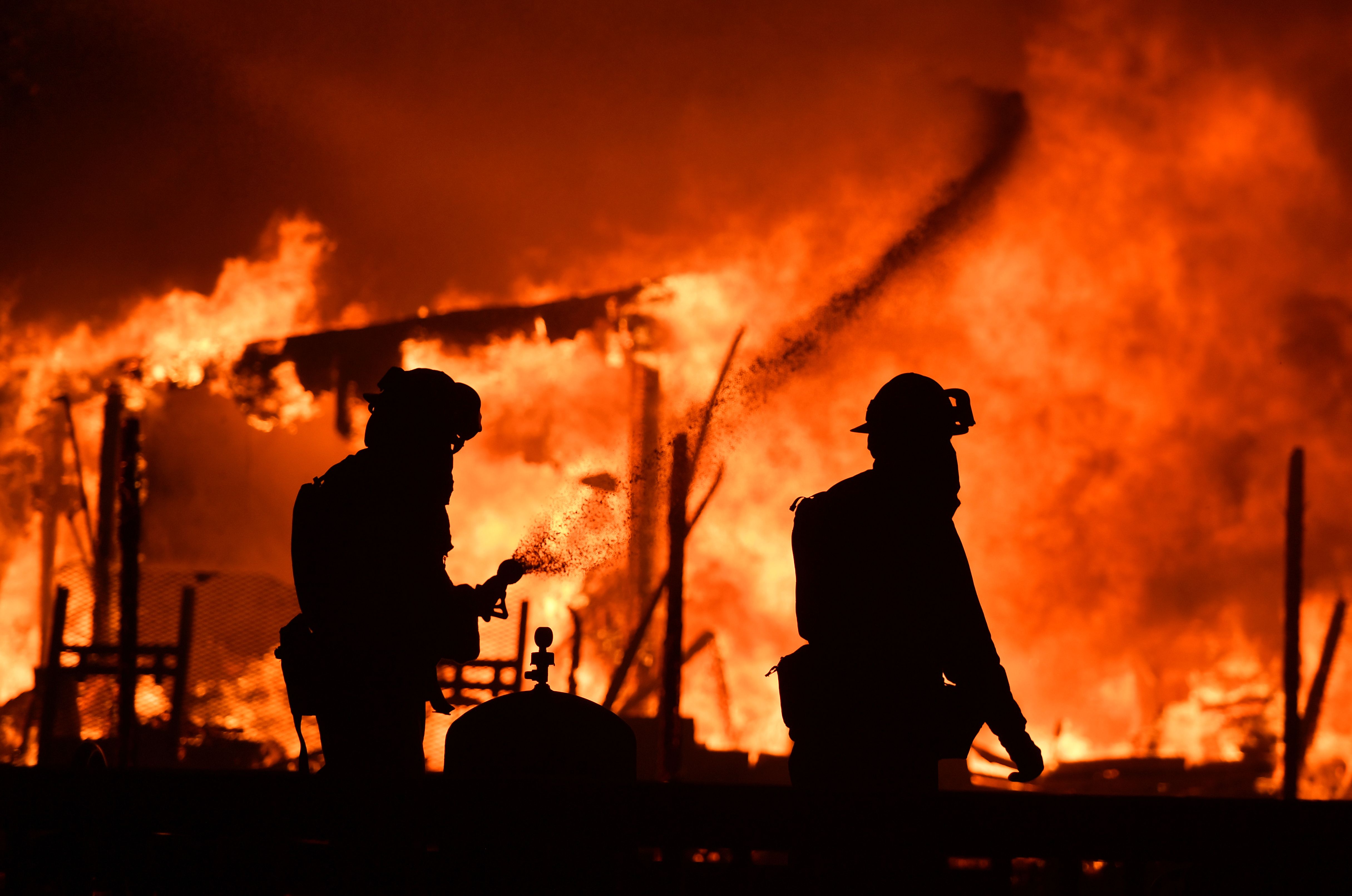
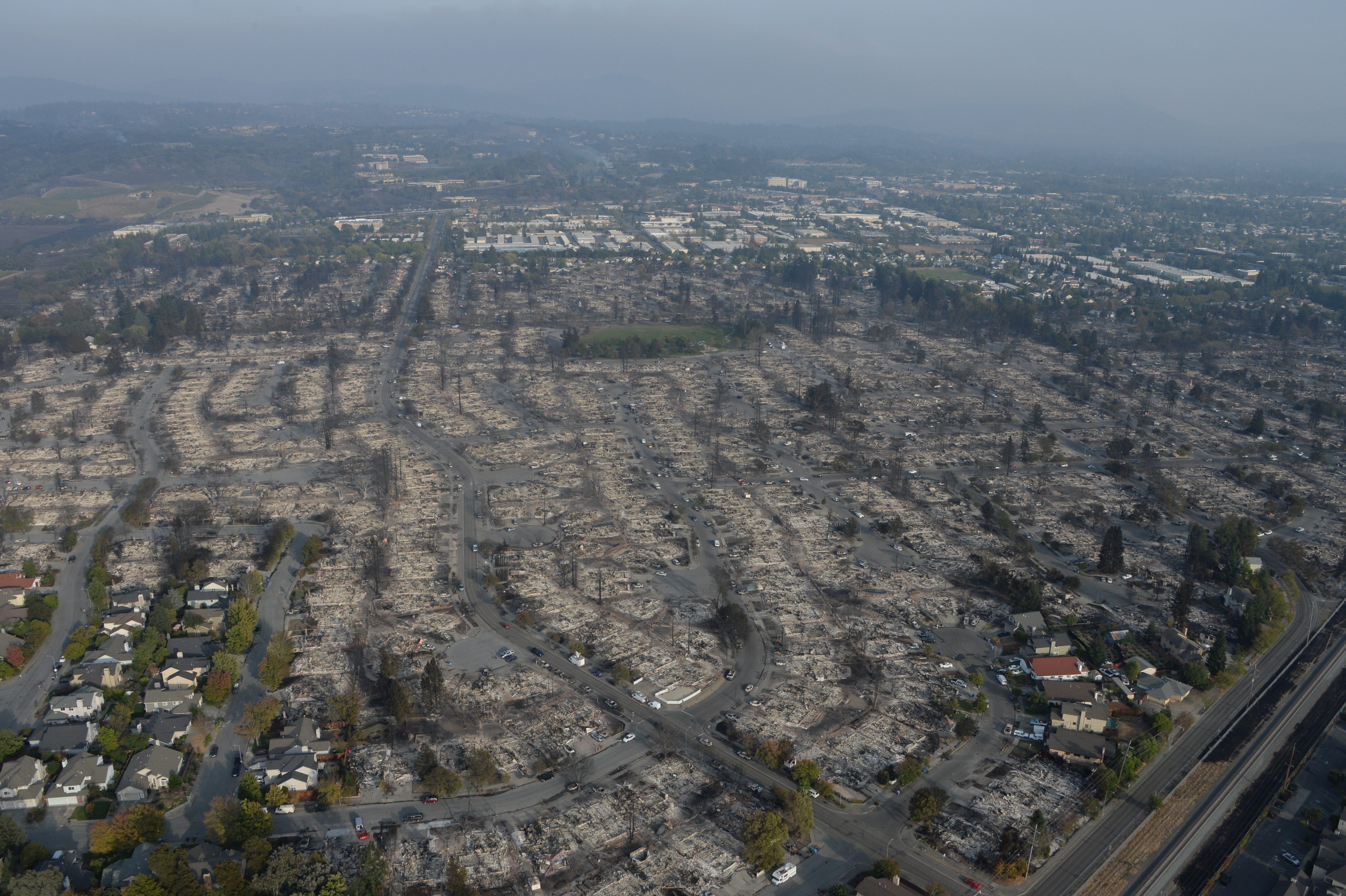
In October 2017, the outbreak of numerous wildfires in Napa, Sonoma, and other northern California counties scorched more than 200,000 acres (81,000 hectares) and burned thousands of homes. More than 40 people were killed. In December, massive wildfires burned near Los Angeles and in Ventura and Santa Barbara counties, northwest of Los Angeles.
In January 2018, a powerful storm struck wildfire-burned areas in Santa Barbara County, causing flash flooding and mudslides that killed at least 20 people. Some of the largest wildfires in California history burned during the summer of 2018. In November, the Camp Fire spread through the Sierra Nevada foothills in the north-central part of the state. The fire, named for its origin along Camp Creek Road in Butte County, destroyed more than 15,000 buildings, including nearly all the homes in the town of Paradise. Eighty-six people were killed in the fire, which officials called the deadliest single wildfire in state history. In southern California, strong winds propelled the spread of the Woolsey Fire in and near the cities of Malibu and Thousand Oaks, west of Los Angeles.
In August 2020, lightning strikes sparked hundreds of fires throughout the state. The fires occurred during a period of extreme heat and drought. In northern California, fires destroyed thousands of buildings and caused dozens of deaths. Wildfires also burned in several parts of southern California. Fires—several of them among the largest in state history—continued to burn into the autumn months. A drought emergency was declared for most parts of the state in 2021. Continuing severe drought led authorities to implement emergency water conservation measures in 2022.
A series of heavy storms in late 2022 and early 2023 caused extensive flooding and contributed to hundreds of landslides in the state. At least 20 Californians were killed. The storms, which resulted from weather phenomena known as atmospheric rivers, also helped replenish the state’s reservoirs.
Mass shootings.
On Dec. 2, 2015, a mass shooting occurred at a social services center in San Bernardino. Two assailants killed 14 people and wounded many others before being killed by police. Law enforcement officials concluded that the assailants had been inspired by the Islamic State, a radical militant Islamic group also known as ISIS or ISIL. On Nov. 7, 2018, a gunman killed 12 people at a country music bar in Thousand Oaks. On Jan. 21, 2023, a gunman killed 11 people at a dance studio in Monterey Park, near Los Angeles.
COVID-19 pandemic.
In early 2020, California became one of the first U.S. states to face severe economic and social disruptions due to the COVID-19 pandemic. COVID-19, a sometimes-fatal respiratory disease caused by a type of coronavirus, infected communities throughout the world after it first emerged from China in late 2019. Public health officials urged Californians to take precautions to limit the virus’s spread, including social distancing and frequent hand washing.
In mid-March 2020, a group of six San Francisco Bay area counties imposed a stay-at-home order to fight an outbreak of the disease. Governor Gavin Newsom imposed a broader lockdown a few days later, closing businesses considered “nonessential” and public gathering places. In May, with infection rates in decline, many businesses were allowed to reopen under strict public health guidelines. In the months that followed, officials raised or lowered business restrictions based on the severity of local infection rates. The distribution of COVID-19 vaccines became the major focus of efforts to fight the disease in 2021. By 2023, more than 12 million Californians had recovered from infection with COVID-19, and more than 100,000 had died.
In early 2021, conservative opponents of Governor Newsom, weary of coronavirus restrictions and critical of his immigration policies, began a campaign to remove him from office. Newsom had been elected in 2018 with more than 60 percent of the vote. Activists collected more than 1,500,000 signatures to trigger a recall election. In September 2021, however, California voters decisively rejected the recall effort.
